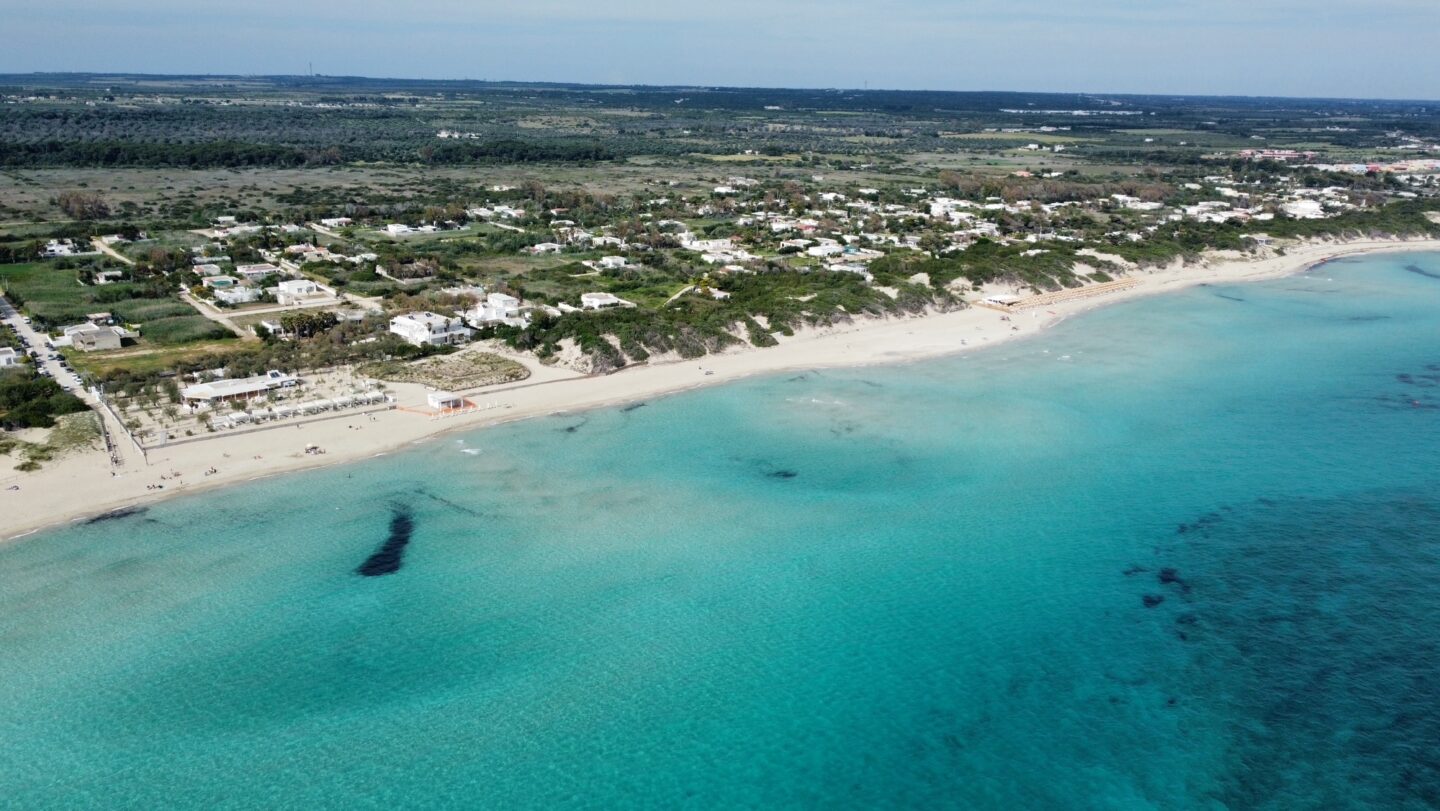If Italy were a boot, Puglia would be the heel — sunny, relaxed, and full of charm. It may not be as famous as Tuscany or the Amalfi Coast, but it offers something even better: real local life, beautiful places, and room to explore without the crowds.
I spent 1 week road-tripping through Puglia, weaving from hilltop villages to coastal towns, past endless olive groves and dry stone walls. What I found was a region that moves to a slower rhythm – where whitewashed houses reflect the afternoon sun, seafood is caught the same day it’s served, and every alley seems to hold a secret.
Whether you’re dreaming of cliffside swims, trulli houses, candlelit dinners in stone courtyards, or discovering baroque towns with barely a tourist in sight – Puglia has a way of stealing your heart. This guide will help you plan the ultimate trip, with must-sees, hidden gems, practical tips, and all the flavor this beautiful corner of Italy offers.
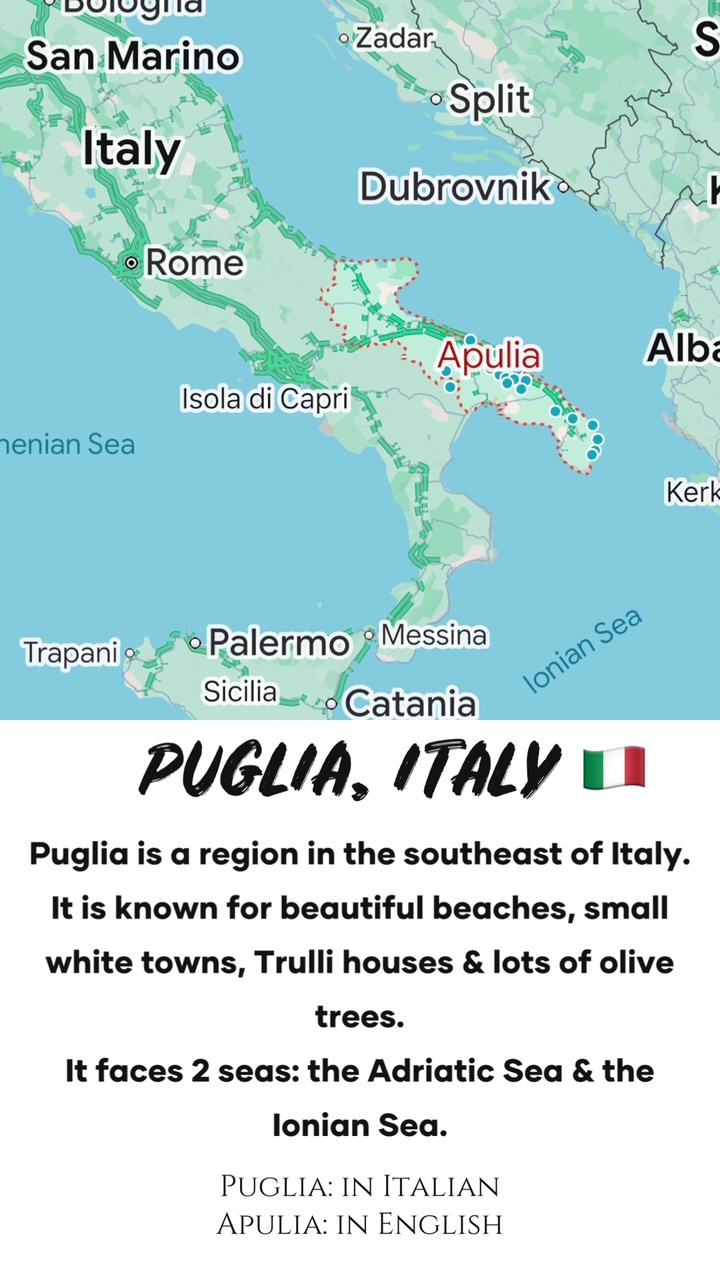
HOW TO GET THERE & AROUND
The easiest way to get to Puglia is by flying into one of its two main airports:
- Bari (Karol Wojtyła Airport) – Great if you’re starting in the central or northern part of Puglia.
- Brindisi Airport – Best if you’re heading to the southern part or beaches near Lecce and Gallipoli.
Both airports have rental car offices, so you can pick up your car right after you land.
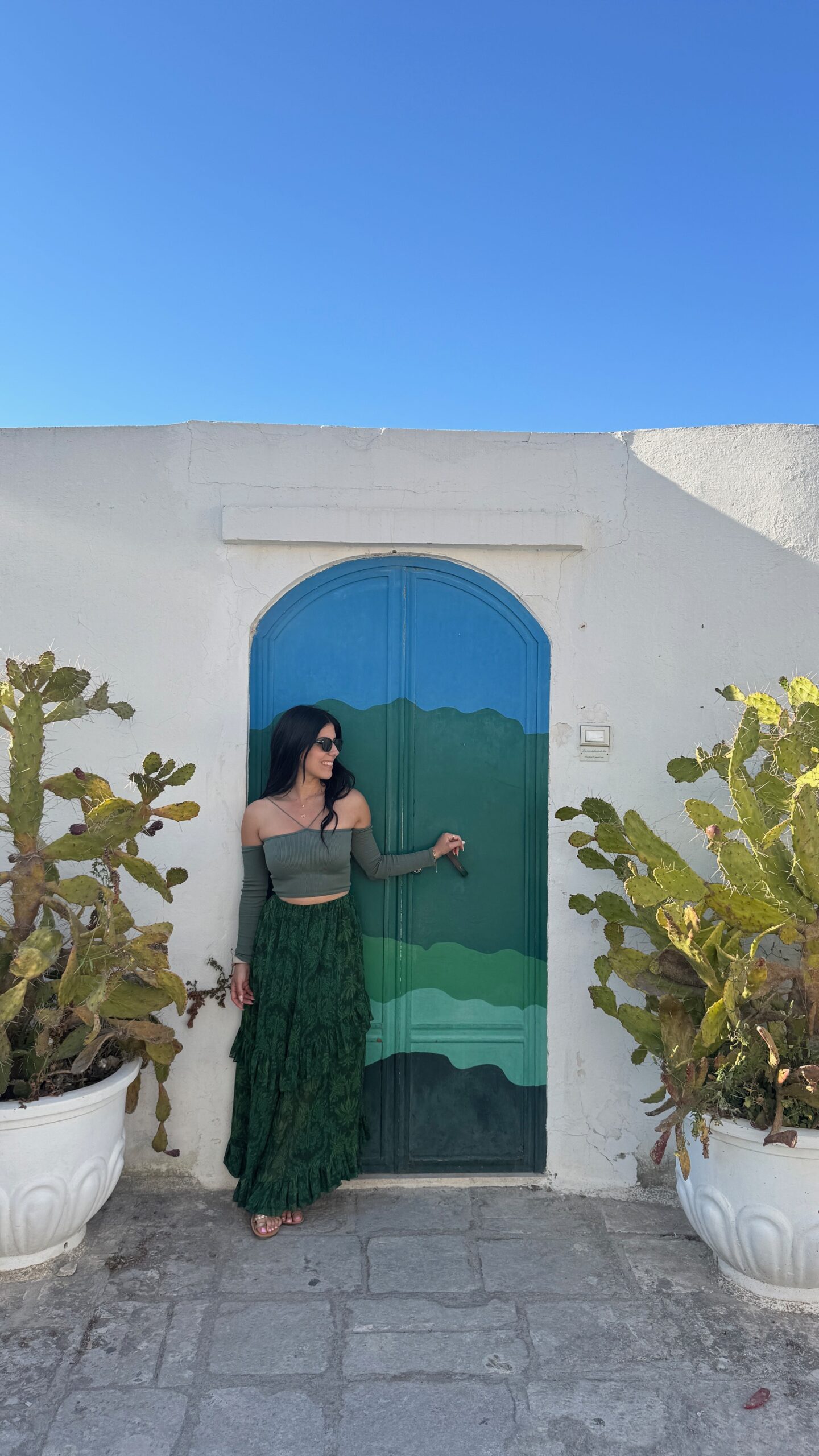
Porta Azurra – Ostuni
Do You Need a Car in Puglia?
Yes. A car is the best way to explore Puglia. Many of the beautiful towns and beaches are far from each other and not connected by train or bus. With a car, you can go at your own pace, stop in small villages, and take country roads through olive groves.
Angel’s tip: I usually book my rental cars through rentalcars.com, where I can easily compare prices and read reviews before choosing the company with the best rating and the deal that fits my budget. For this trip, I booked with Lucauto and had a good experience!
Puglia boasts a comprehensive train network operated by several companies, in case you don’t have a car:
- Trenitalia: Connects major cities such as Bari, Lecce, Brindisi, Taranto, and Foggia.
- Ferrovie del Sud Est (FSE): Serves smaller towns including Alberobello, Martina Franca, Locorotondo, and Otranto.
- Ferrovie Appulo Lucane (FAL): Links Bari with inland towns like Altamura and Gravina in Puglia.
Driving in Puglia
Driving in southern Italy can feel a bit wild at times—but don’t worry! Just keep these in mind:
- People don’t always use turn signals.
- Scooters might zoom past you.
- Roundabouts are common—slow down and go with the flow.
- Stay calm, drive slowly, and enjoy the view!
Parking Tips
White lines = Free parking
Blue lines = Paid parking (pay at machines or use apps like EasyPark)
Yellow lines = Reserved (don’t park there)
Try to park outside the old town (centro storico) and walk in. Many towns have narrow streets or limited access zones (ZTL), where you could get fined if you drive without permission. I didn’t find many private parking areas.
Angel’s tip: Siesta Time Is Real. From about 2 PM to 5 PM, most shops and restaurants close. Towns can feel completely empty—but don’t worry, it’s just nap time! Plan your day around it.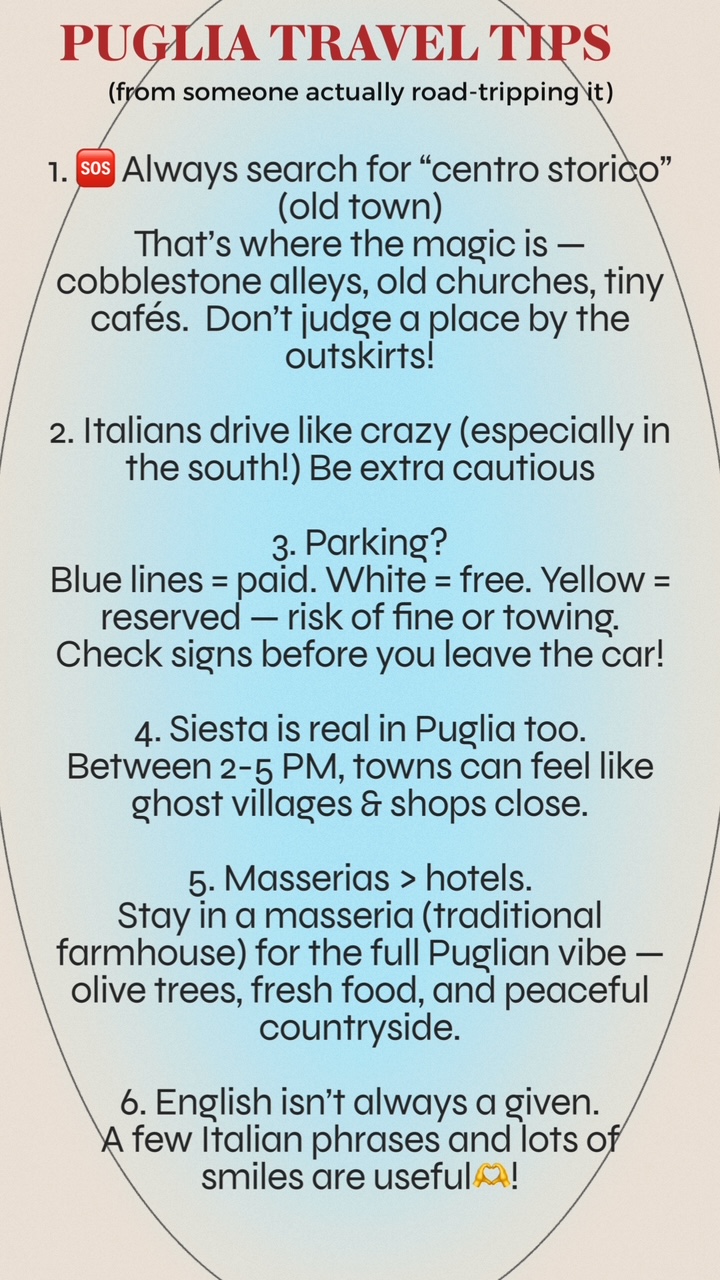
WHAT MAKES PUGLIA SPECIAL?
Puglia is one of those places where every corner offers something special. Here’s what makes it truly unique:
- Beaches – From Sandy Shores to Rocky Retreats
Puglia is home to some of the best beaches in Italy. Whether you prefer long sandy stretches or more rocky, secluded spots, you’ll find something to suit your vibe. The Adriatic coast (like Monopoli and Otranto) offers crystal-clear waters and picturesque coves. The Ionian coast (like Gallipoli and Punta Prosciutto) is known for turquoise waters and golden sand. Perfect for swimming, sunbathing, and beach walks.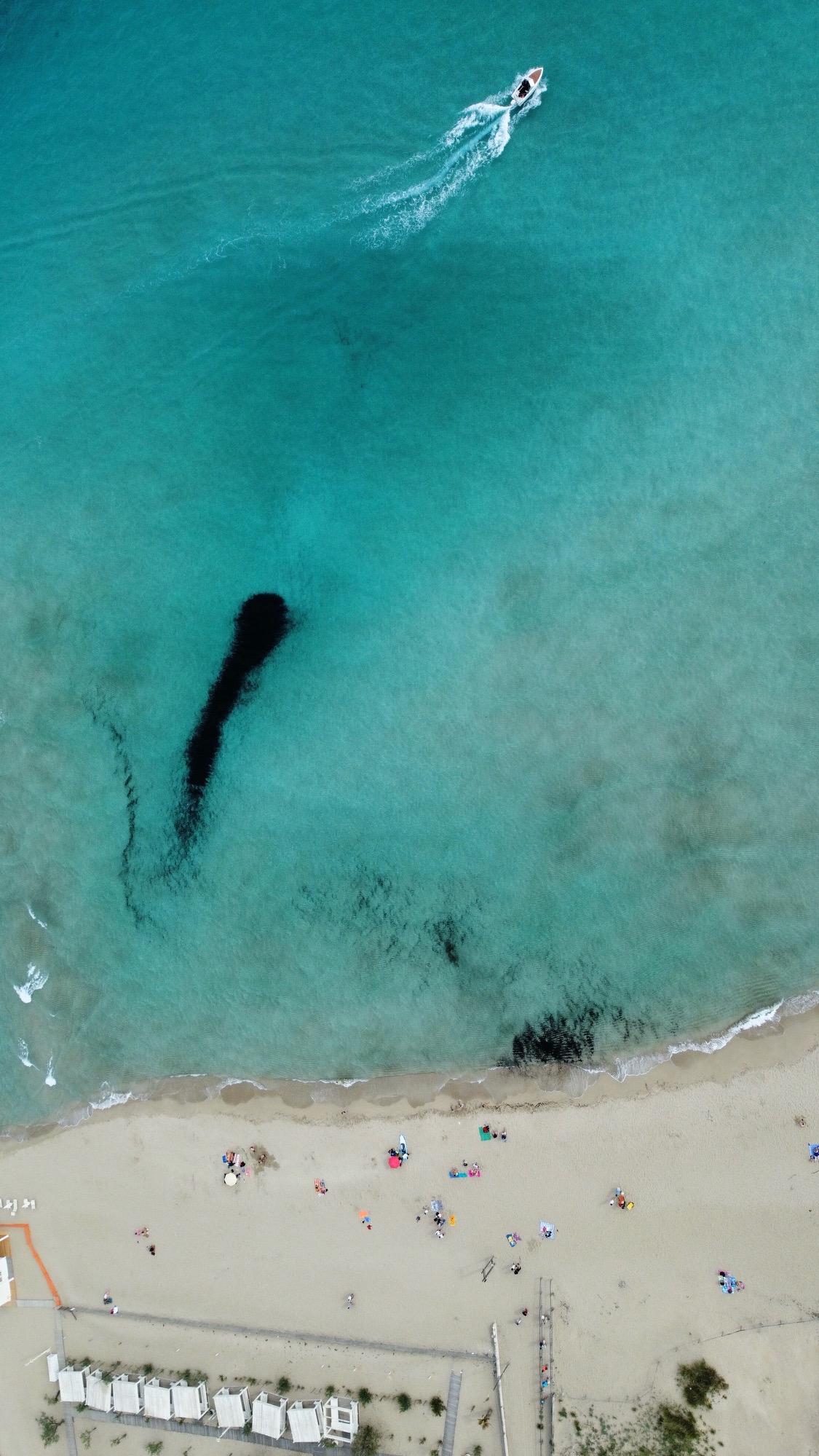
- Trulli Houses – Iconic Stone houses
Puglia is the home of the trulli, the iconic round stone houses with conical roofs. Alberobello is the most famous place to see these, and it’s a UNESCO World Heritage Site. Walking through the streets of Alberobello, with its fairytale-like trulli, is a must for any visitor to Puglia.
- Olive Oil – A Liquid Gold
Puglia is Italy’s olive oil capital, and it’s said to produce some of the best olive oil in the world. You’ll find ancient olive groves and many olive oil farms offering tastings. Try buying local, fresh olive oil as a souvenir or enjoying it in traditional dishes like orecchiette.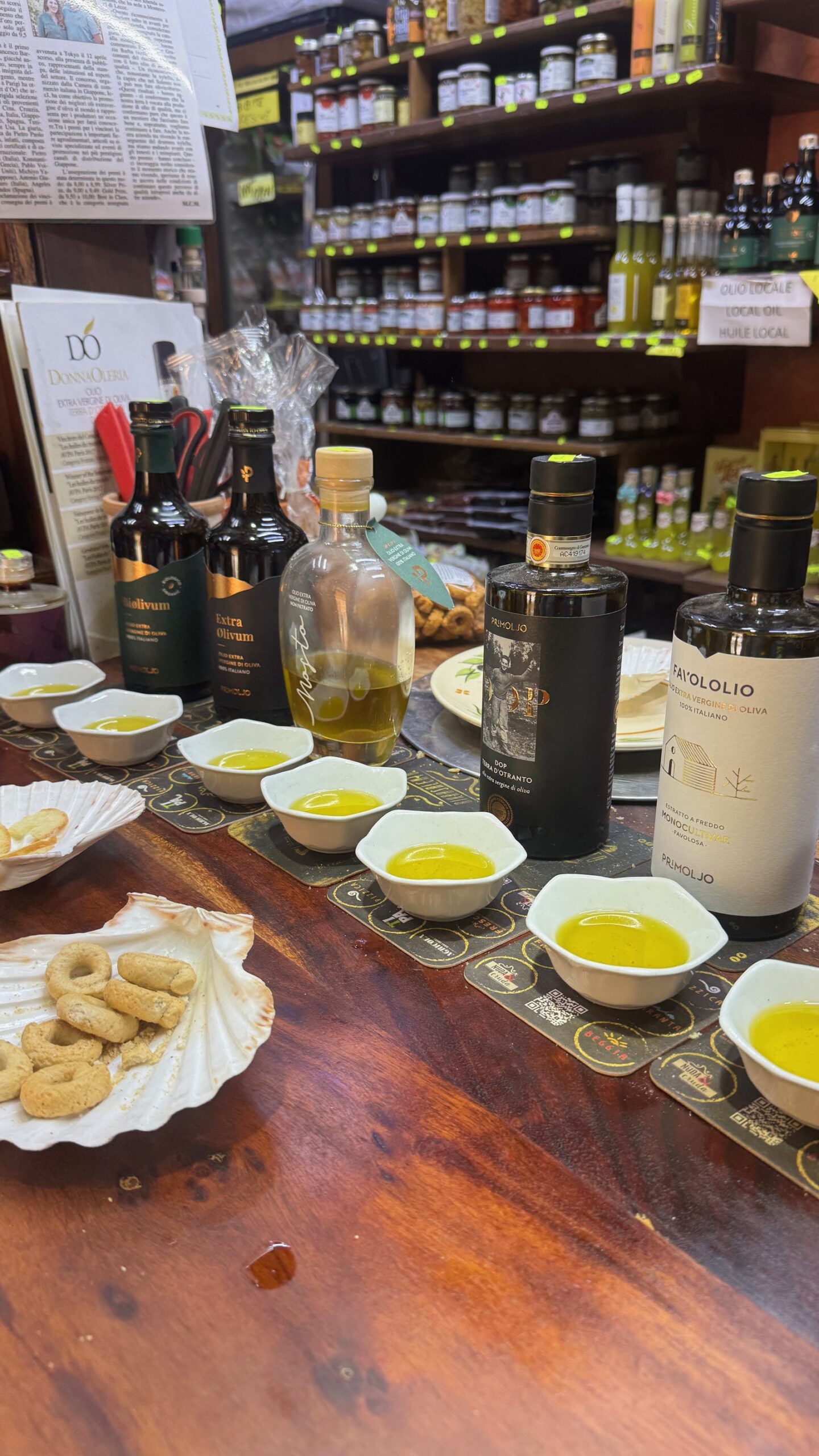
- Stunning Old Towns – Whitewashed Charm
The charm of Puglia lies in its old towns, many of which are made up of narrow, winding streets, whitewashed buildings, and colorful balconies. Ostuni (The White City) is an architectural marvel on a hill, with stunning views over the olive groves and sea. Monopoli and Polignano a Mare also feature beautiful coastal old towns, full of history, local life, and charm.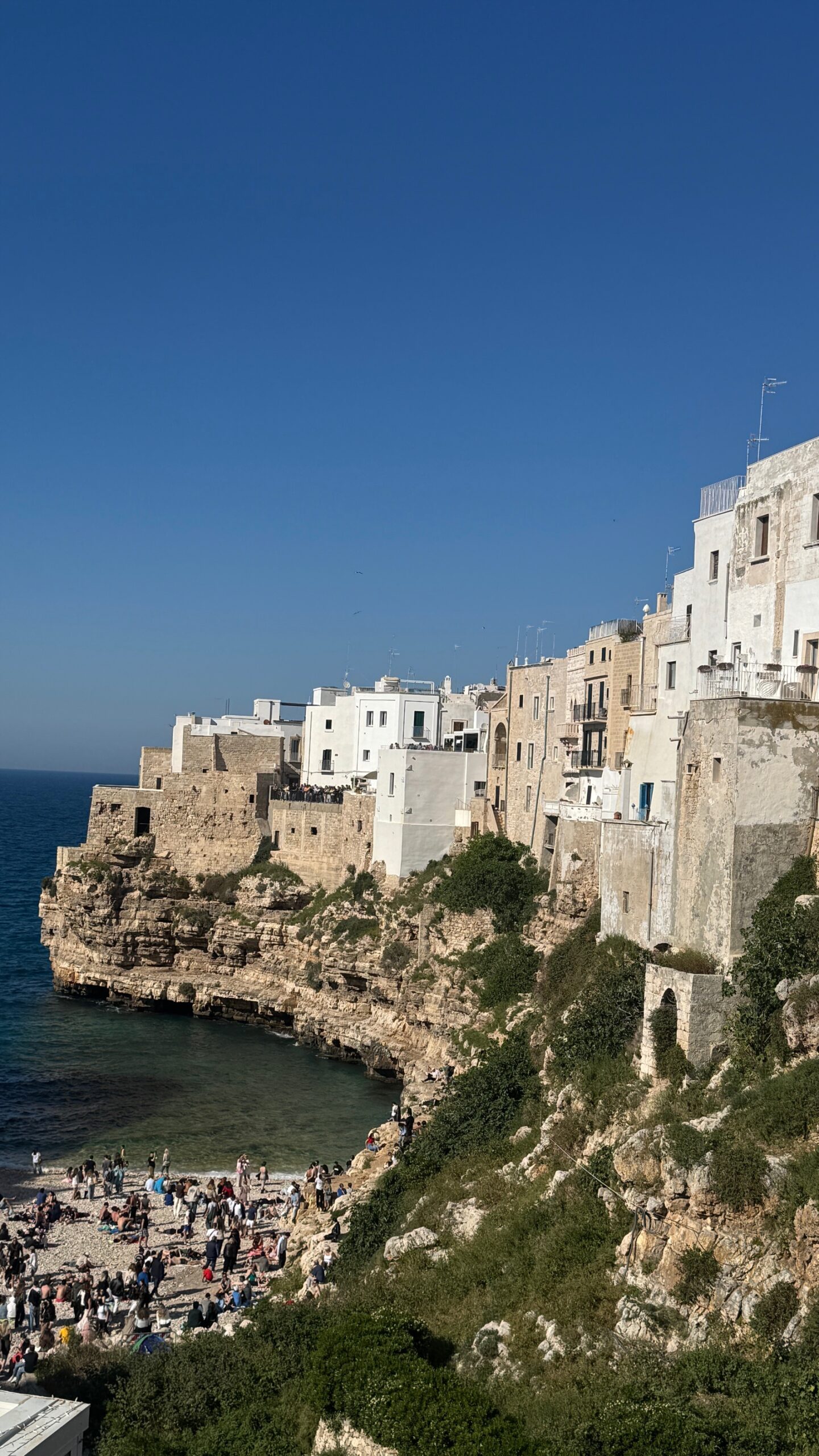
- Food – Simple, Fresh, and Full of Flavor
Puglia’s food is simple but flavorful, with a focus on fresh, local ingredients. You’ll find a range of dishes, from handmade orecchiette pasta to burrata cheese and focaccia barese. The seafood is also excellent. And don’t forget to try some local wines, especially Primitivo!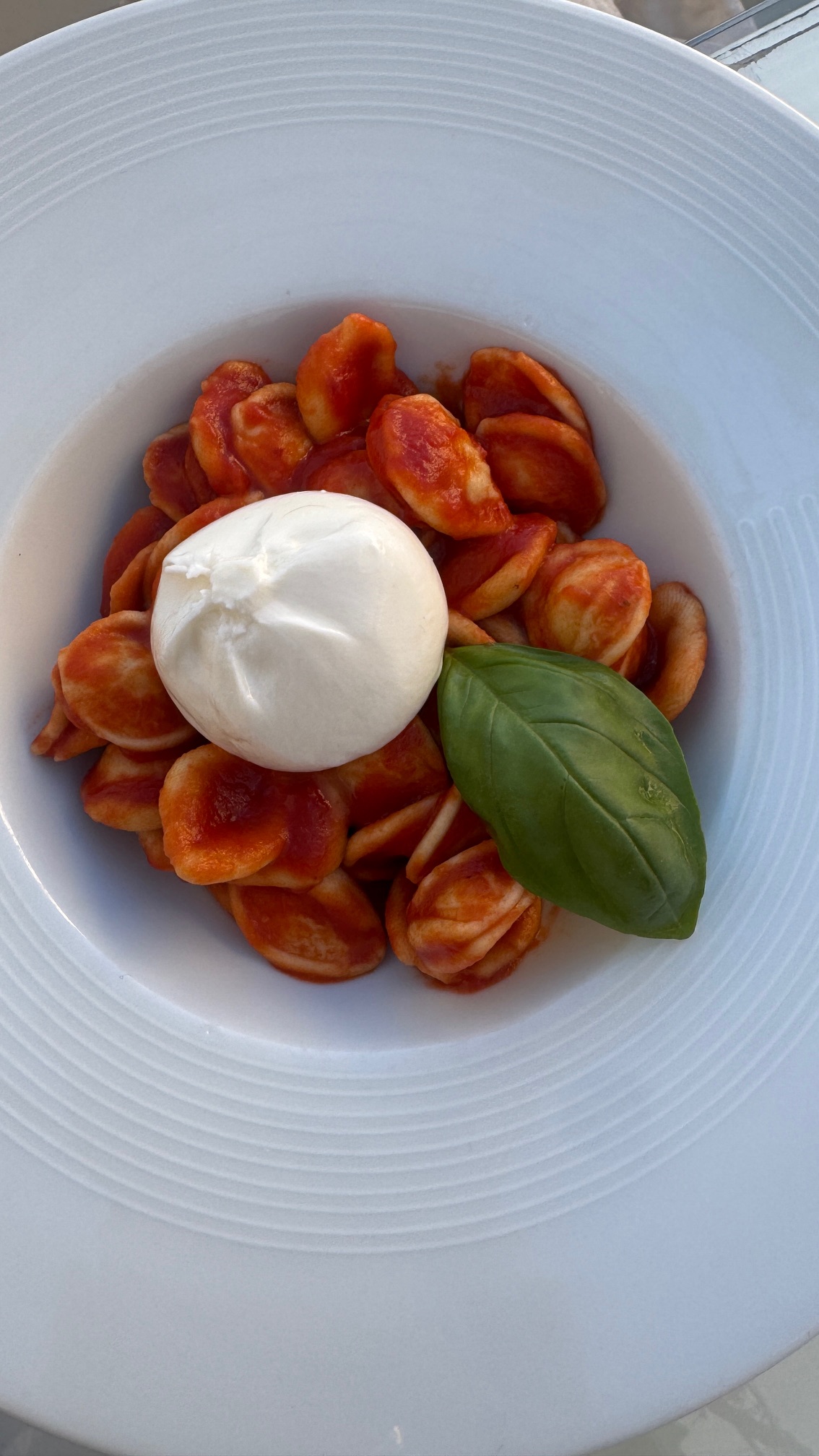
- Unique Architecture – Baroque and Beyond
While the trulli are famous, Puglia also boasts amazing baroque architecture. Lecce, known as the “Florence of the South,” is filled with intricate baroque churches and palaces. The town of Martina Franca also has lovely baroque buildings and a charming old town to explore.
Puglia truly offers a mix of natural beauty, rich history, delicious food, and unique architecture that makes it a standout destination in Italy.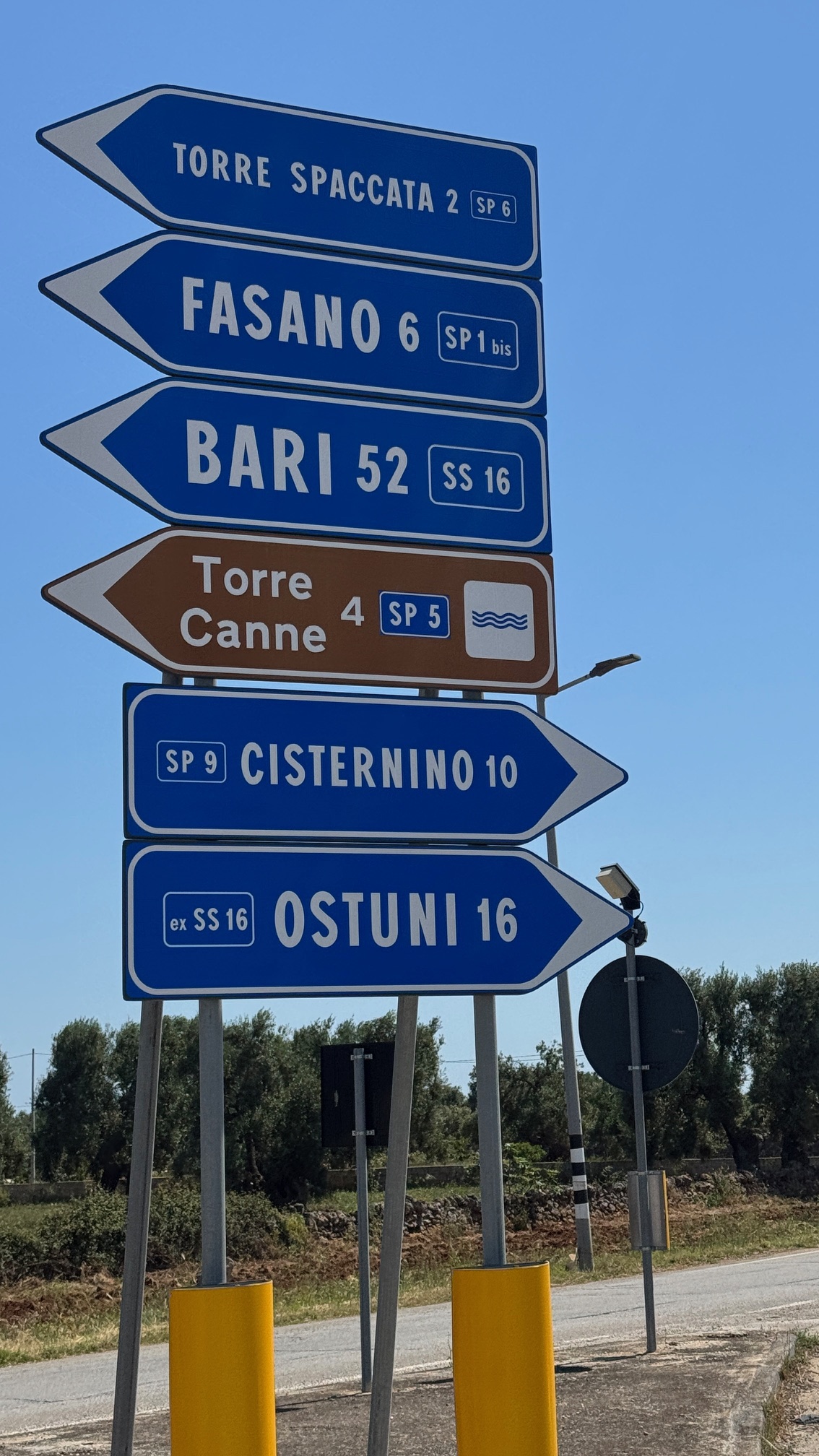
WHERE TO STAY – ONE BASE OR MULTIPLE?
Should you stay in one place or move around? Both options work – it depends on what kind of trip you want. Deciding where to stay can really change the vibe of your trip. I stayed in Monopoli, just outside the old town, which worked well for me, but here are a few options depending on your travel style:
- One Base – Monopoli
If you prefer staying in one place and driving around to explore, Monopoli is a great choice. It’s central, with easy access to towns like Polignano a Mare, Alberobello, Ostuni, and Cisternino. It’s not far from Taranto or Matera either. Plus, you’ll find great restaurants and a charming old town to relax in at night. Angel’s tip: I stayed outside the old town on Via Margherita, which made parking easy.
- Split Your Stay – Monopoli & Lecce/Gallipoli
For a more relaxed experience, consider splitting your stay into two bases: Monopoli for central Puglia (easy access to all the towns mentioned above). Lecce or Gallipoli for the southern part of Puglia, with great beaches and charming towns like Otranto and Nardo. Angel’s tip: This way, you won’t spend too much time driving each day.
- Experience Countryside – Stay in a Masseria
For a unique, peaceful experience, stay in a masseria (traditional farmhouse). It’s a perfect way to experience the countryside of Puglia. You’ll get to enjoy the olive trees, homemade meals, and the slow-paced life of rural Puglia. Some masserias offer cooking classes, wine tastings, or olive oil tours, so it’s a great way to experience local life.
- Visit Matera
If you have time, spend one night in Matera or at least devote one whole day (it’s technically in Basilicata, but close enough to Puglia). Matera is famous for its ancient cave dwellings (Sassi). Sleeping in a cave hotel is something truly special and fits perfectly with a Puglia road trip.
Angel’s tip: This is a personal choice, but splitting your stay between two spots or spending a night in Matera will help you make the most of your time in Puglia and minimize driving time.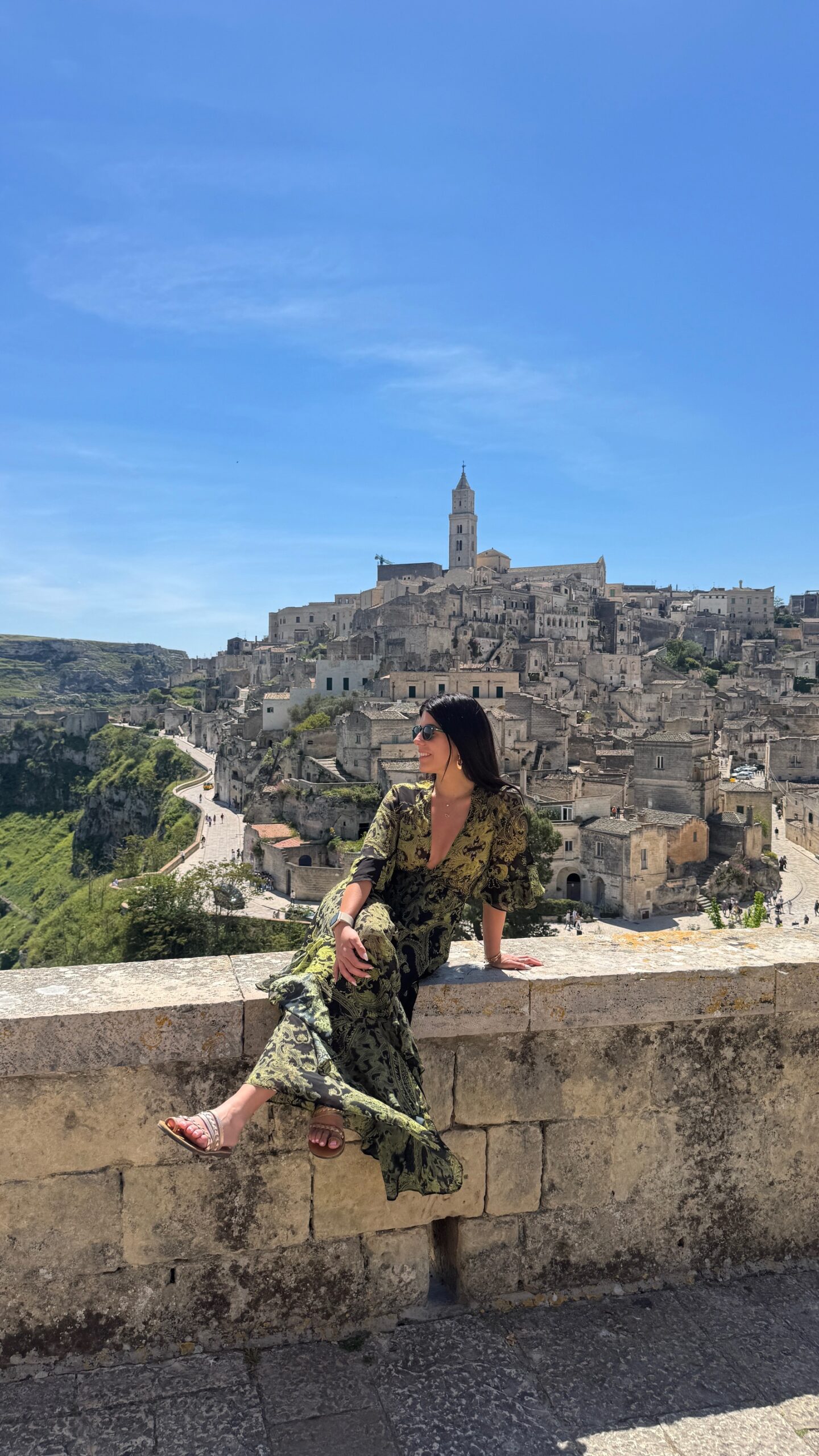
MUST-SEE TOWNS IN PUGLIA
Puglia is full of beautiful towns—some famous, others more secret. Here are the ones you shouldn’t miss:
These towns are popular for good reason. They’re full of beauty, history, and charm. Puglia is full of charming towns and cities that capture the essence of the region. From the dramatic coastline to the historic old towns, here’s a guide to the must-do cities and what to see and do in each.
Angel’s tip: Always Search for “Centro Storico”. Don’t judge a town by its outskirts. The magic always happens in the old town—tiny streets, balconies with laundry, and cats sunbathing in the sun. That’s where you’ll fall in love.
Monopoli
A coastal town with a delightful mix of old-world charm and modern seaside vibes. Things to do in Monopoli:
- Explore the Old Town: Wander through narrow, cobblestone streets lined with whitewashed buildings and vibrant doors. Check out the Piazza Giuseppe Garibaldi and the cathedral.
- Visit the Castle of Carlo V: A historic castle right on the sea, it offers panoramic views of the coastline and is a great spot for photos.
- Relax at the Beaches: Monopoli has some lovely beaches, like Cala Porta Vecchia and Cala Paradiso, perfect for a day of sun and swimming.
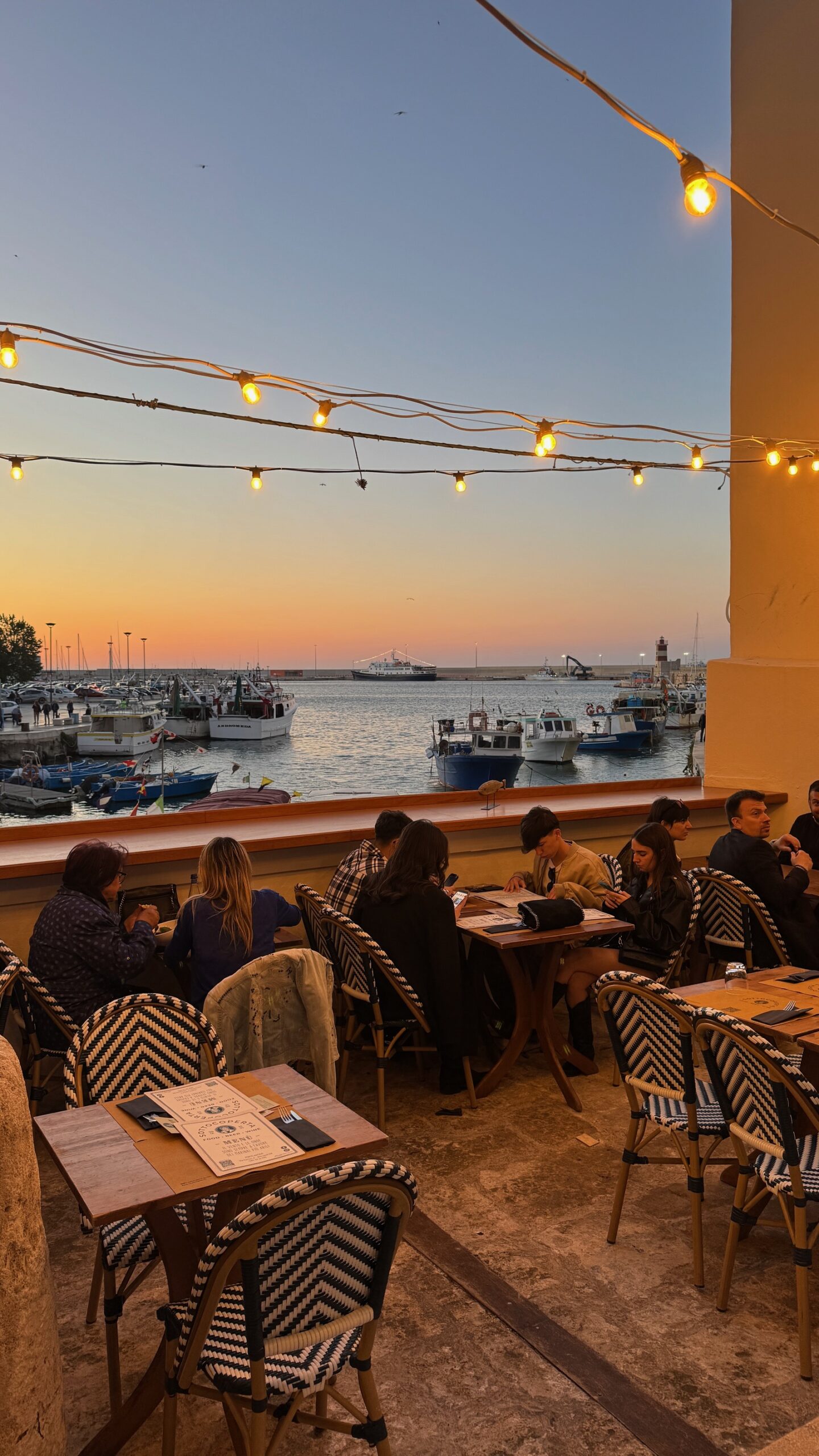
Sottocoperta pub in Monopoli
Polignano a Mare
Known for its stunning cliffs and blue waters, Polignano a Mare is one of the most beautiful coastal towns in Puglia.
Things to do in Polignano a Mare:
- Visit Lama Monachile Beach: This small beach is surrounded by cliffs, with crystal-clear waters. It’s the perfect spot for a swim or a relaxing day by the sea.
- Admire the Views from the Cliffs: The town’s clifftop views are breathtaking. Don’t miss the Domenico Modugno statue at the viewpoint, a tribute to the famous Italian singer.
- Explore the Old Town: Wander the maze of alleys with whitewashed buildings and beautiful views of the Adriatic. Stop by a local café to try pasticiotto (a traditional pastry).
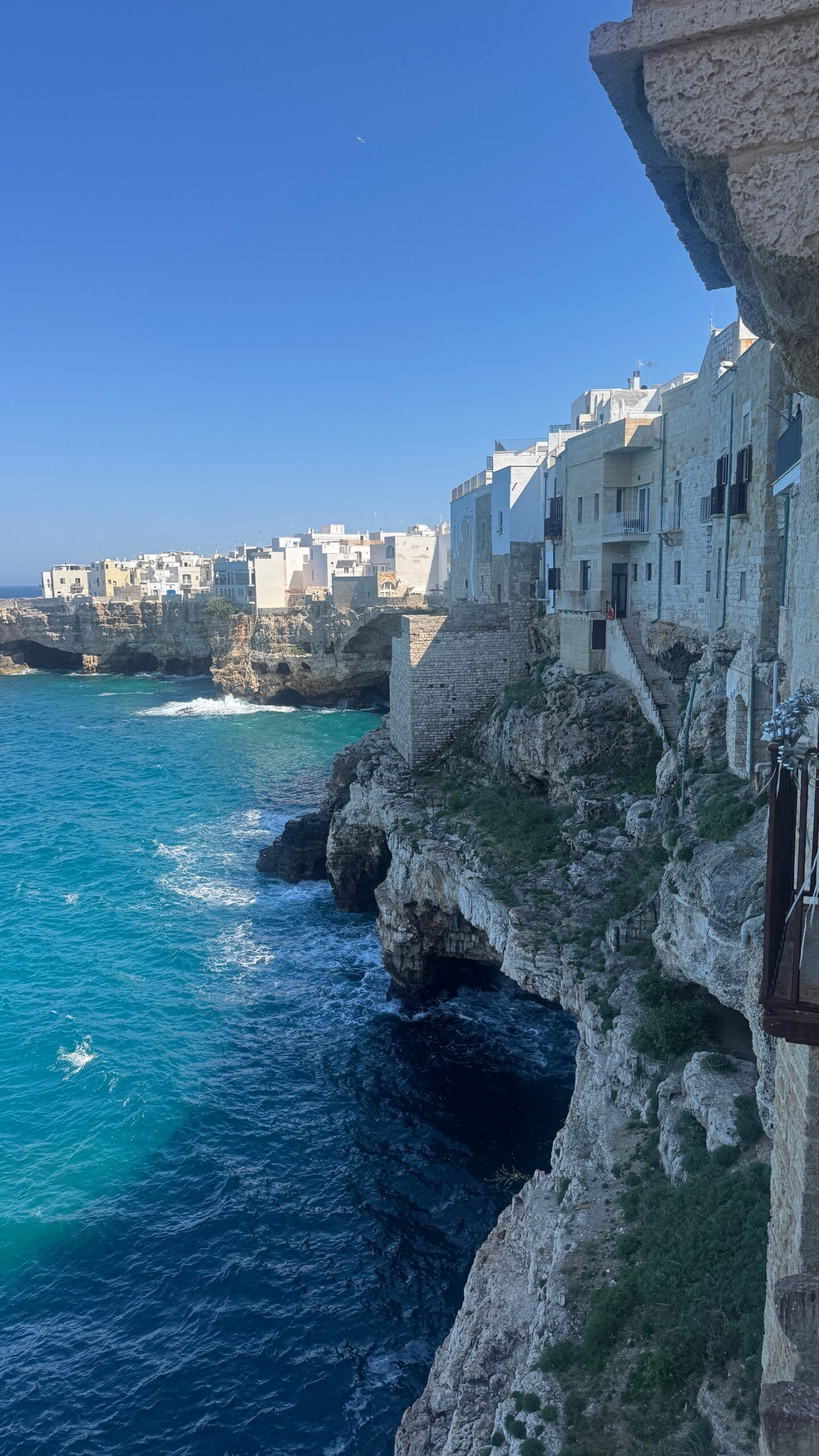
Alberobello
Alberobello is famous worldwide for its trulli houses — the distinctive stone houses with conical roofs. It is a UNESCO World Heritage site. Angel’s tip: I loved it, it is so unique but touristy. Go as earlier possible to avoid the crowds.
Things to do in Alberobello:
- Explore the Trulli Zone (Rione Monti): This is the most famous area in Alberobello, where you can walk among hundreds of these iconic homes.
- Visit Trullo Sovrano: The largest trullo in town, this historical building is a museum that shows what life was like in these unique houses.
- Enjoy the View from the Belvedere: Head to the Belvedere Santa Lucia for a stunning view of the town and its famous trulli.
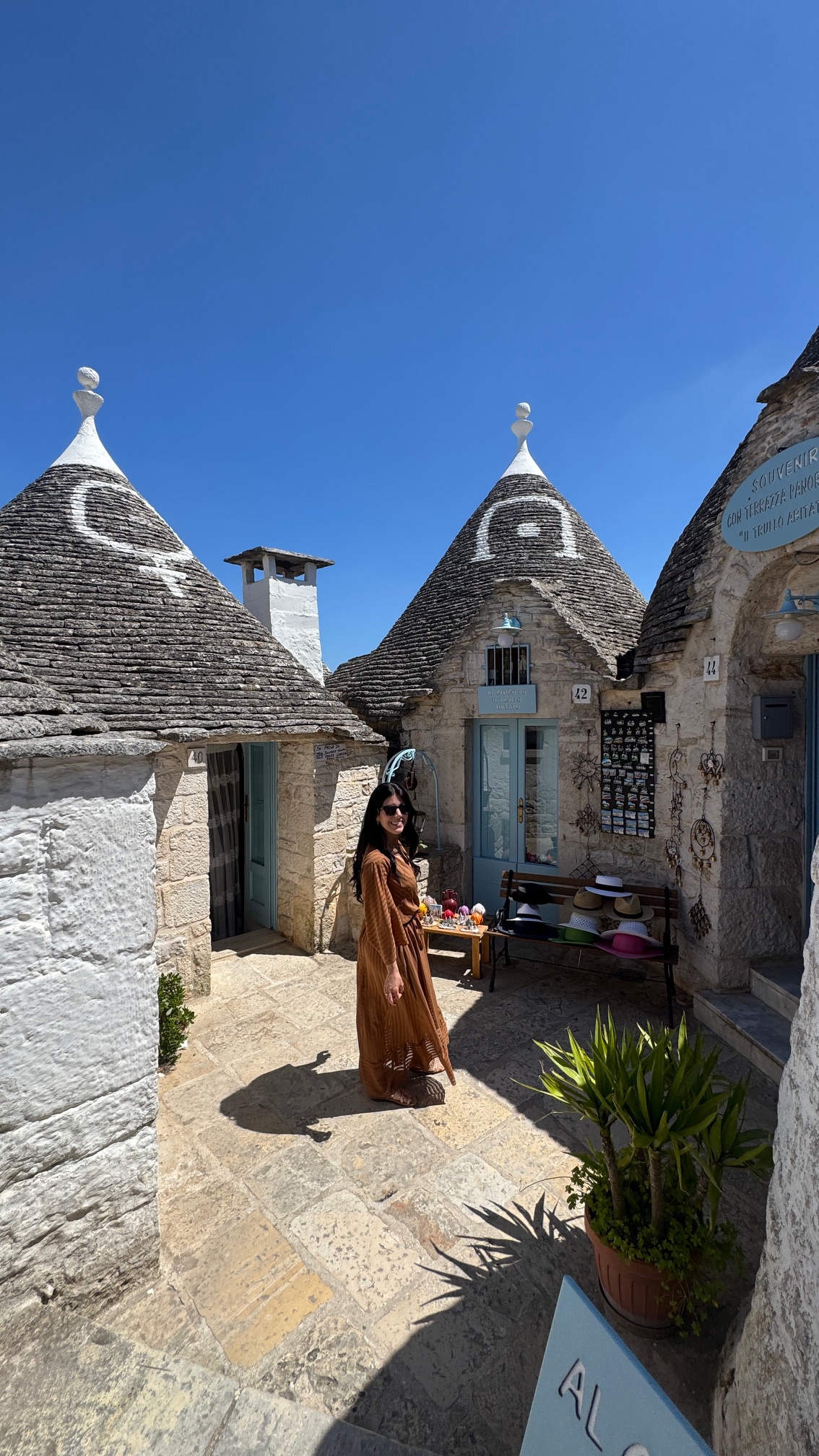
Ostuni
Perched on a hill with panoramic views of the Adriatic Sea and olive groves, Ostuni, also known as the “White City”, is a must-visit for its beauty and history. Things to do in Ostuni:
- Wander the Old Town: Get lost in the maze of narrow alleys, whitewashed houses, and stunning staircases. The town is especially magical during the golden hour when the sun reflects off the white stone.
- Visit the Ostuni Cathedral: Located at the highest point of the town, this late-Gothic cathedral has a beautiful rose window and offers amazing views of the surrounding countryside.
- Relax at Piazza della Libertà: This central square is the heart of the town. Enjoy a coffee, aperitivo, or gelato while people-watching. Angel’s tip: Don’t miss to visit Borgo Antico bistrot for a drink or food. Especially during sunset!
- Visit the City Walls: The views from the city walls over the surrounding olive groves and the sea are incredible, especially at sunset.
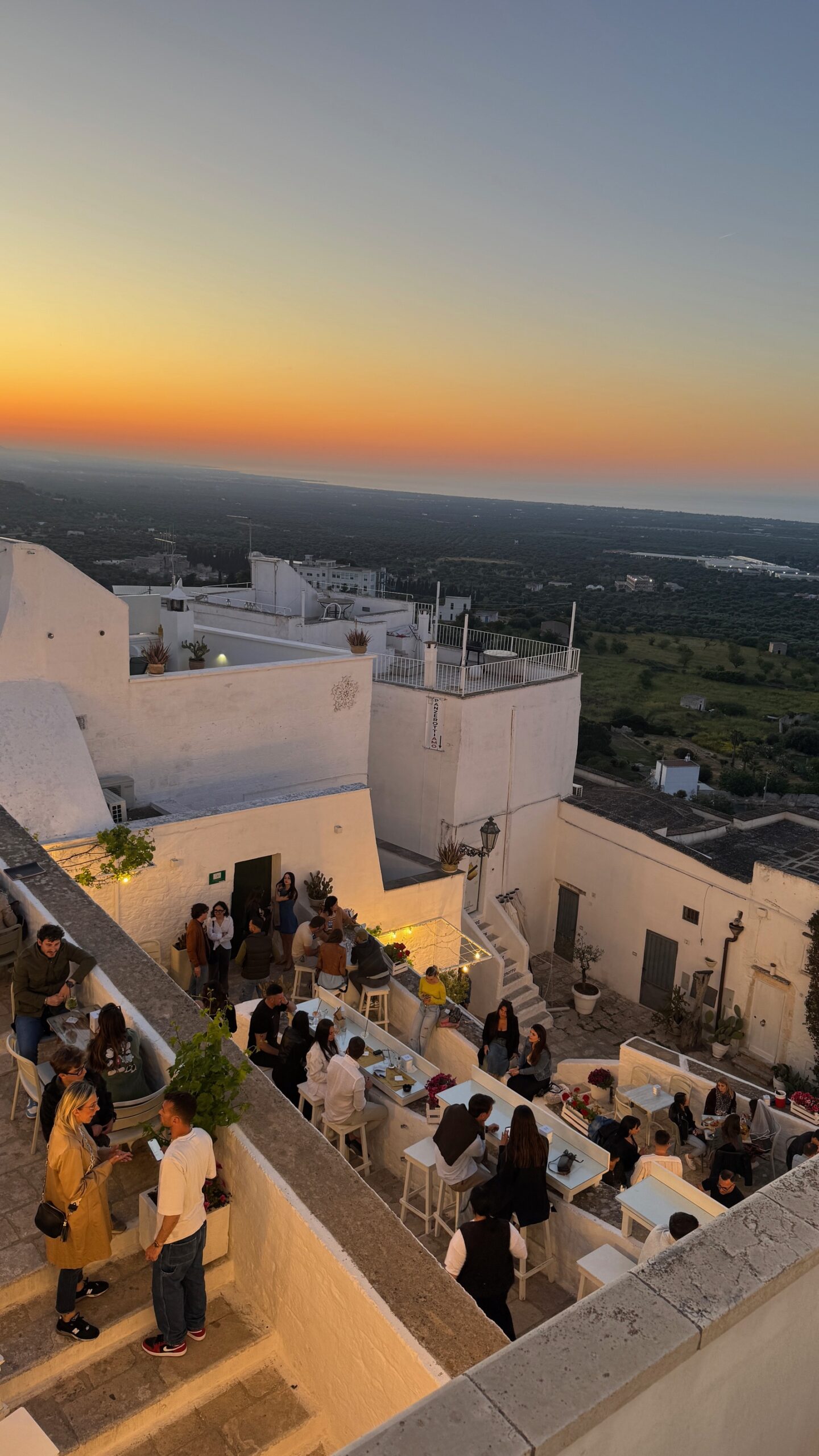
Borgo Antico Bistrot
Cisternino
A slow-paced, charming town in the heart of the Valle d’Itria, known for its narrow alleys, whitewashed buildings, and its reputation for some of the best grilled meats in Puglia. Things to do in Cisternino:
- Wander the Old Town: Cisternino’s old town is full of narrow, winding streets, making it perfect for a relaxing stroll. You’ll find picturesque squares, charming little shops, and beautiful white houses. Take time to get lost in the town’s peaceful atmosphere.
- Visit the Church of San Nicola: This beautiful baroque church in the town center is a great place to admire the architecture and learn about Cisternino’s history.
- Explore the Local Butchers: Cisternino is famous for its grilled meat, especially the local specialty called “bombette” (small rolls of meat stuffed with cheese and herbs). There are many butcher shops where you can buy your meat, and some even have small grills outside where you can enjoy fresh grilled food.
- Relax at Piazza Vittorio Emanuele: This is the central square where you can enjoy a coffee or an aperitivo while people-watching. The square is surrounded by traditional architecture and has a relaxed vibe.
- Enjoy the Panoramic Views: Walk up to the historic center or find a spot along the town’s outskirts for fantastic views over the Valle d’Itria. The rolling hills and olive groves below are a stunning sight, especially at sunset.
Angel’s tip: Visit the Trullo Sovrano: Not far from Cisternino, you can visit the famous trulli (traditional dry stone huts with conical roofs) in the surrounding countryside, a UNESCO World Heritage Site.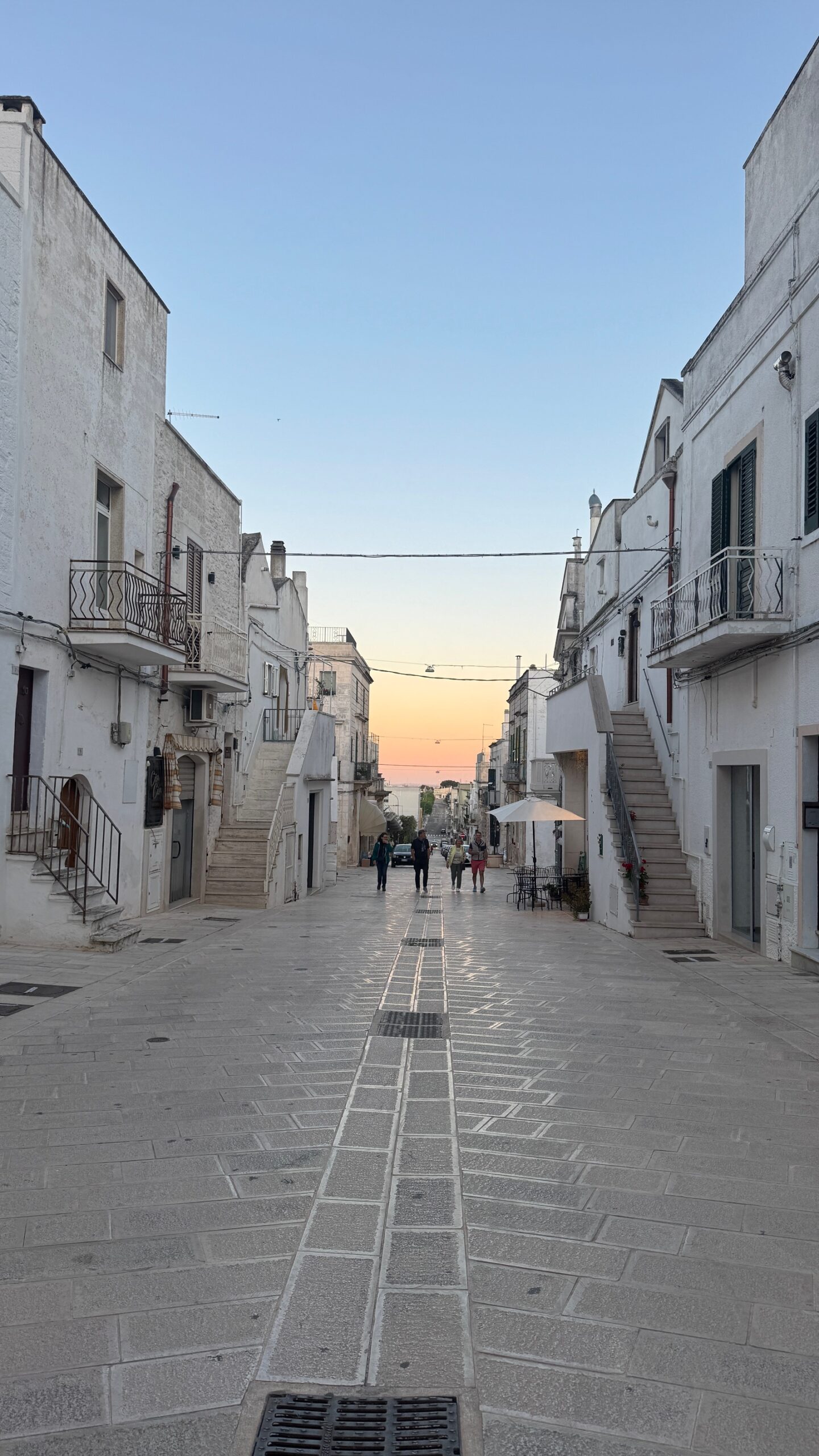
Bari – the capital of Puglia
- Bari Vecchia (Old Town) – Wander through narrow, charming streets where locals make fresh orecchiette pasta and experience the authentic atmosphere.
- Basilica di San Nicola – Visit this important church that holds the relics of Saint Nicholas and admire its impressive architecture.
- Castello Normanno-Svevo – Explore this medieval castle with great views of the city and harbor.
- Lungomare – Enjoy a relaxing stroll along one of Italy’s most scenic seafront promenades.
- Piazzas & Street Life – Immerse yourself in the lively streets full of local markets, cafes, and people.
- Local Cuisine – Try panzerotti (fried dough filled with tomato and mozzarella) and other Puglian delicacies at local eateries.
- Via Basso Arco – A hidden gem in the old town, this picturesque street is lined with traditional homes and offers a glimpse into the city’s authentic charm. Angel’s tip: It is so unique! They make pasta outside their houses!
- Vibrant Atmosphere – A mix of history, culture, and modern life that makes Bari a dynamic and welcoming city.

Via Basso Arco
Angel’s tip: If you have time – and especially if you’re traveling with kids like me with my godson—a great idea is to visit Zoosafari in Fasano, one of the largest wildlife parks in Europe with drive-through safaris and fun attractions. He loved it!
Key Highlights:
-
Drive-Through Safari: Experience a 6-kilometer route in your own vehicle, observing over 3,000 animals from 200 species roaming freely, including lions, tigers, elephants, giraffes, and zebras.
-
Pedestrian Areas: Explore on foot to see primates like gorillas and chimpanzees, as well as leopards, black panthers, and various reptiles and birds.
-
Lake of the Large Mammals: View seals, sea lions, brown bears, polar bears, hippopotamuses, and white rhinos in a naturalistic setting.
-
Fasanolandia Amusement Park: Enjoy rides such as roller coasters, a log flume, ghost trains, and dodgem cars, including the Eurofighter coaster with a 97-degree drop.
Located in Fasano, Puglia, the park is easily accessible and offers a full day of entertainment for families and animal enthusiasts alike. For more information, visit the official website: www.zoosafari.it
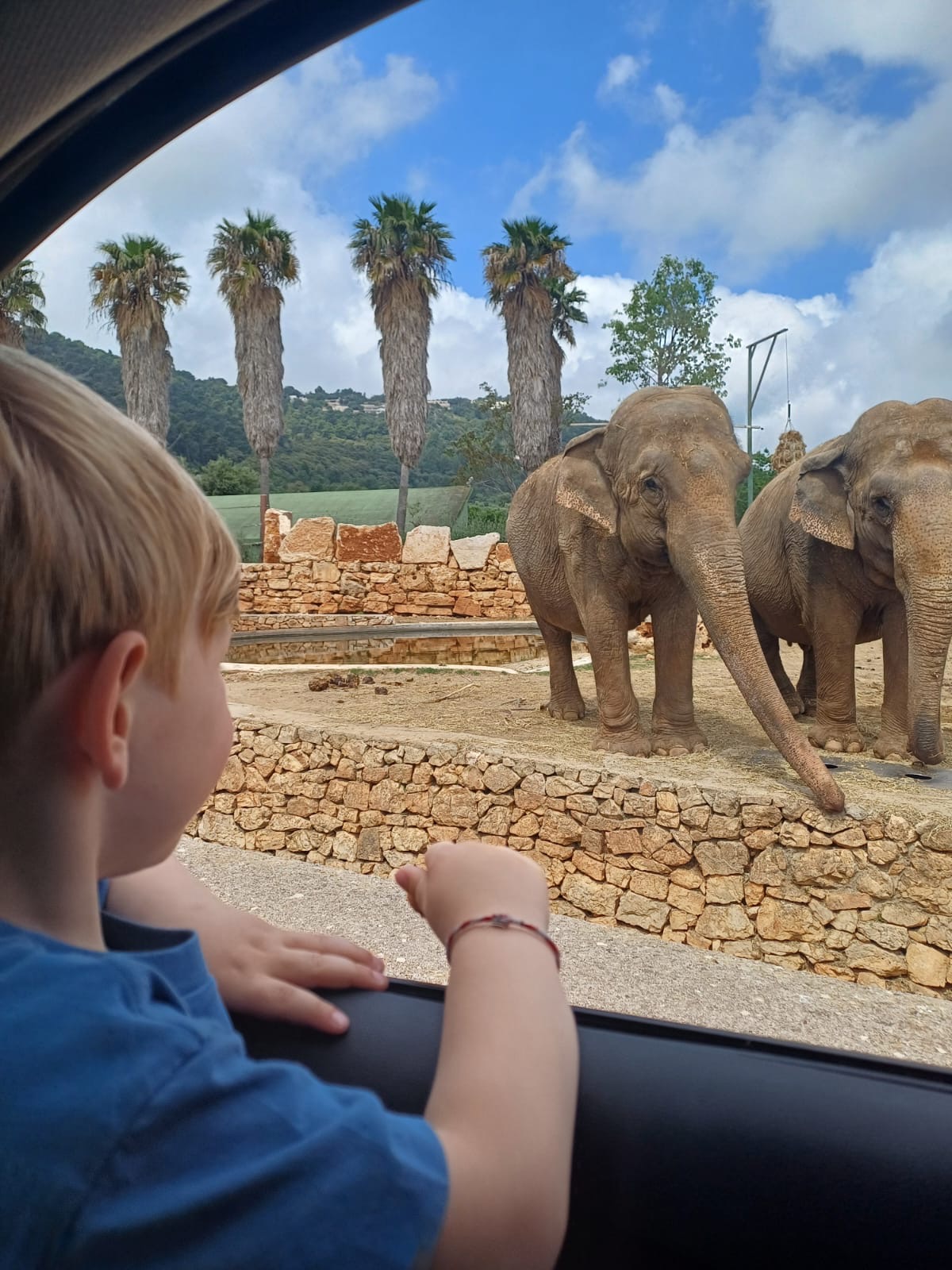
Less Known Puglia Gems
These towns are less touristy but brimming with local charm. You’ll feel like you’ve stumbled upon a hidden secret of Puglia.
- Martina Franca: a charming town known for its elegant baroque architecture and lovely old town. Stroll through Piazza Roma, visit the grand Palazzo Ducale, and don’t miss the beautiful Basilica di San Martino. Perfect for a relaxed walk through narrow, atmospheric streets.
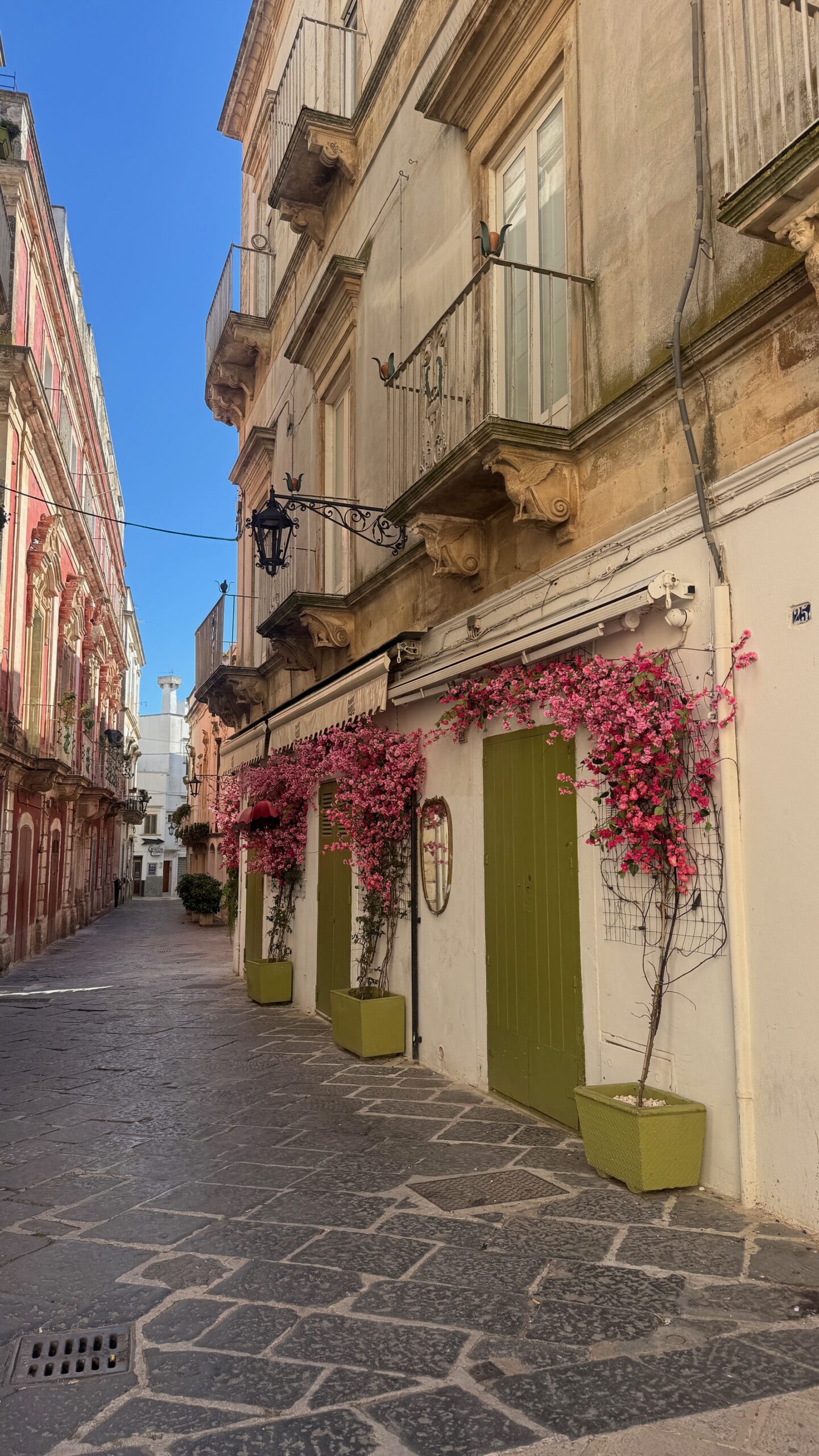
- Locorotondo – Famous for its whitewashed buildings and beautiful hilltop location, Locorotondo offers panoramic views of the surrounding Valle d’Itria. The town is known for its circular layout and picturesque streets, making it a perfect spot for a leisurely walk. Don’t miss the Chiesa Madre, an impressive church in the town’s center, and be sure to try some Locorotondo wine, a fresh white wine from the region.
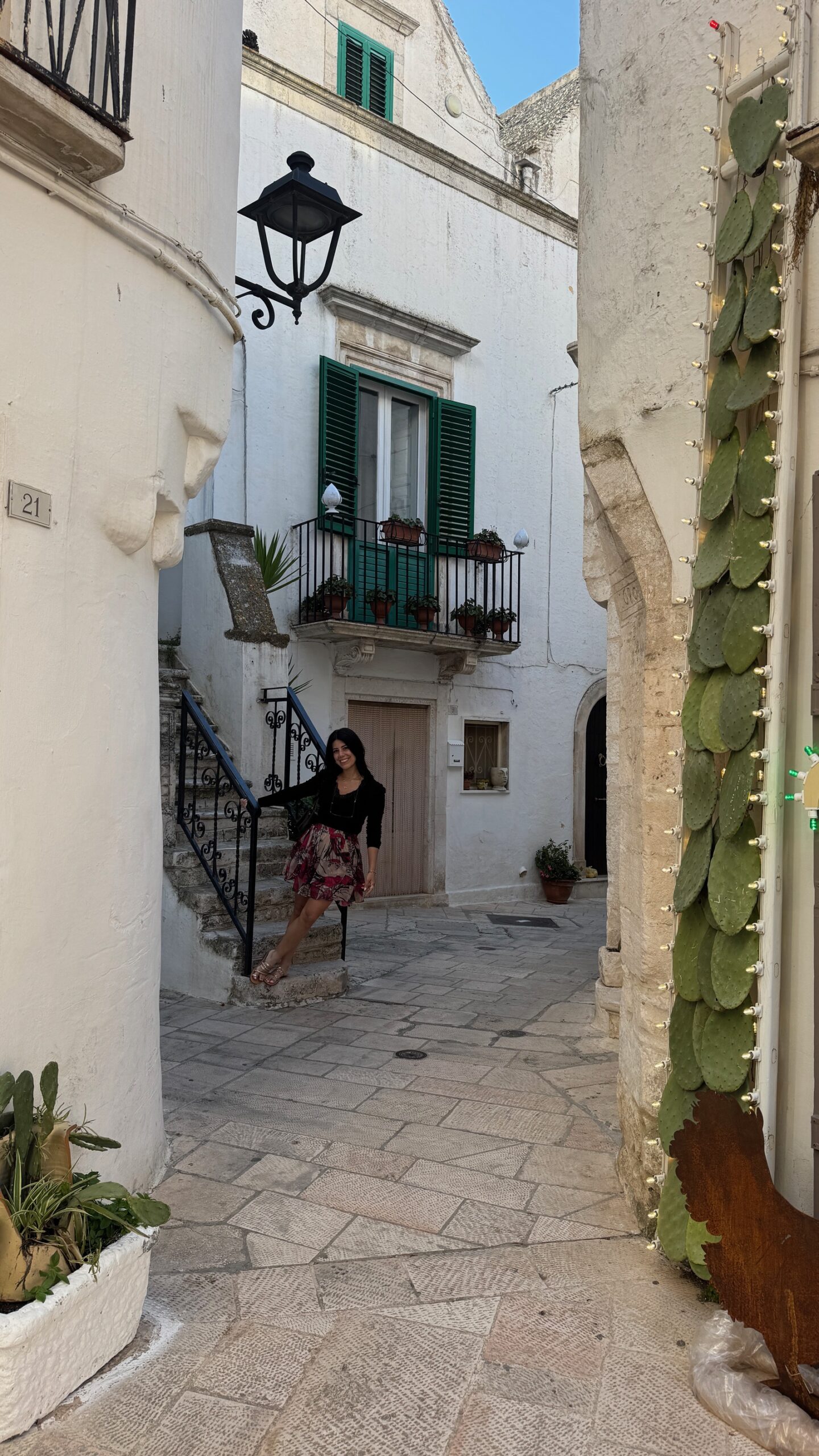
- Ceglie Messapica – Known for its delicious food scene. This town is more laid-back and not fancy, but it’s full of authentic charm. Explore its narrow streets, enjoy a quiet meal at a family-owned trattoria, and visit the historic center with its impressive Norman castle. Ceglie is perfect for those who love to eat well and embrace the slower pace of life.

- Grottaglie – A hidden gem famous for its pottery. If you’re interested in handmade ceramics, Grottaglie is the place to be. You can visit local workshops and see artisans at work creating beautiful, colorful pottery. The town is also home to the Ceramics Museum and offers a unique blend of art and history.
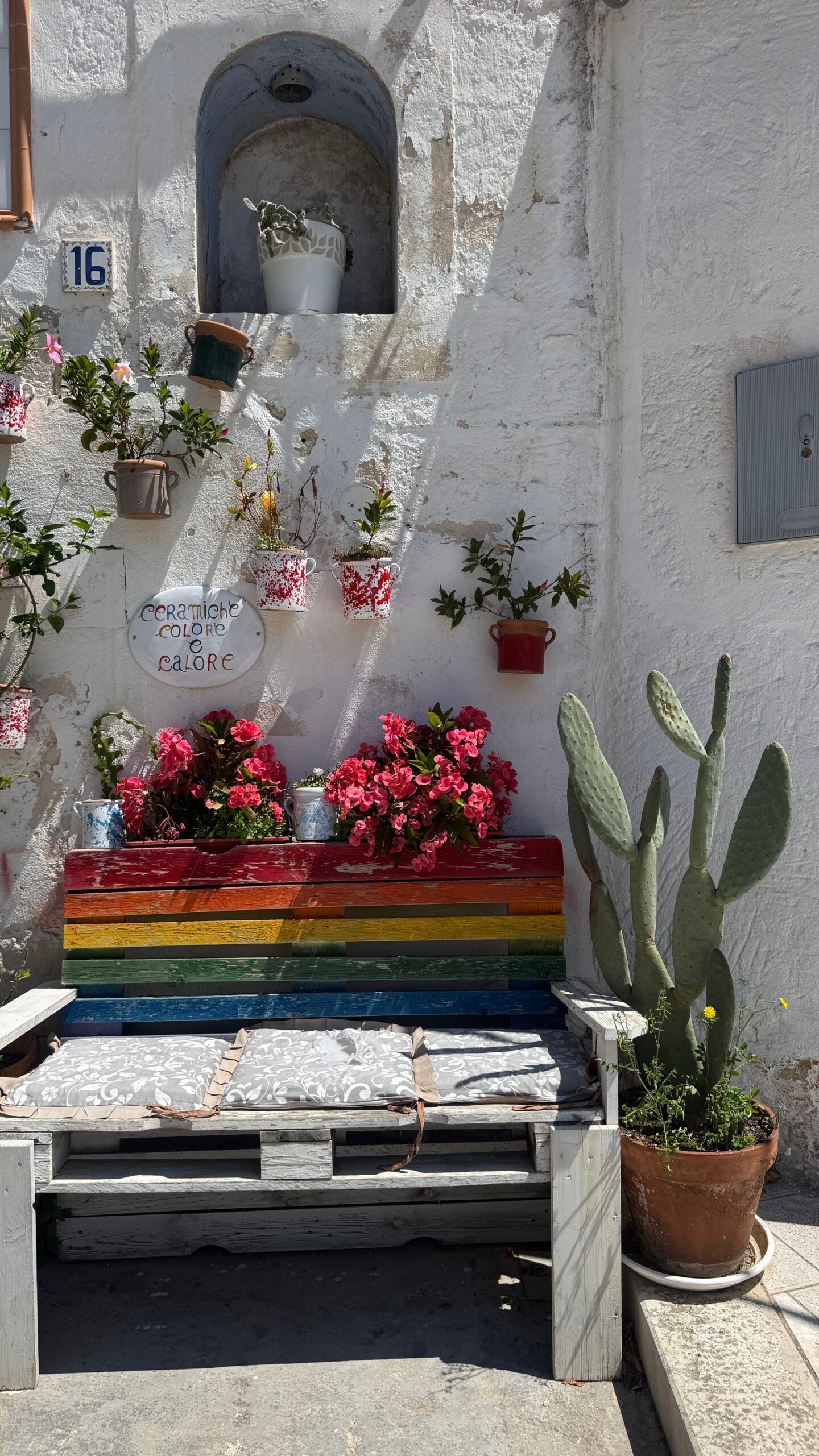
- Nardo – An underrated baroque town located near the stunning Ionian coast. It’s less crowded than Lecce but just as full of history and beauty. Wander through its elegant streets, visit the Piazza Salandra (the main square), and check out the Cathedral of Nardò, a beautiful example of baroque architecture. Nardò is also a great base for visiting nearby Porto Selvaggio, a nature reserve with crystal-clear waters and quiet beaches.
Southern Puglia Highlights
Once you’ve explored central Puglia, head south. The towns get even more relaxed, the beaches more beautiful, and the pace of life even slower:
- Lecce – Often called the “Florence of the South,” Lecce is a stunning city filled with beautiful baroque buildings, churches, and vibrant cafes. It’s a fantastic place to walk around and immerse yourself in the local culture. The Piazza del Duomo is beautiful and the Roman Theatre offers a glimpse into the city’s ancient past. Angel’s tip: If you’re short on time, you can skip Lecce. My expectations were high, but honestly, it didn’t quite live up to them.
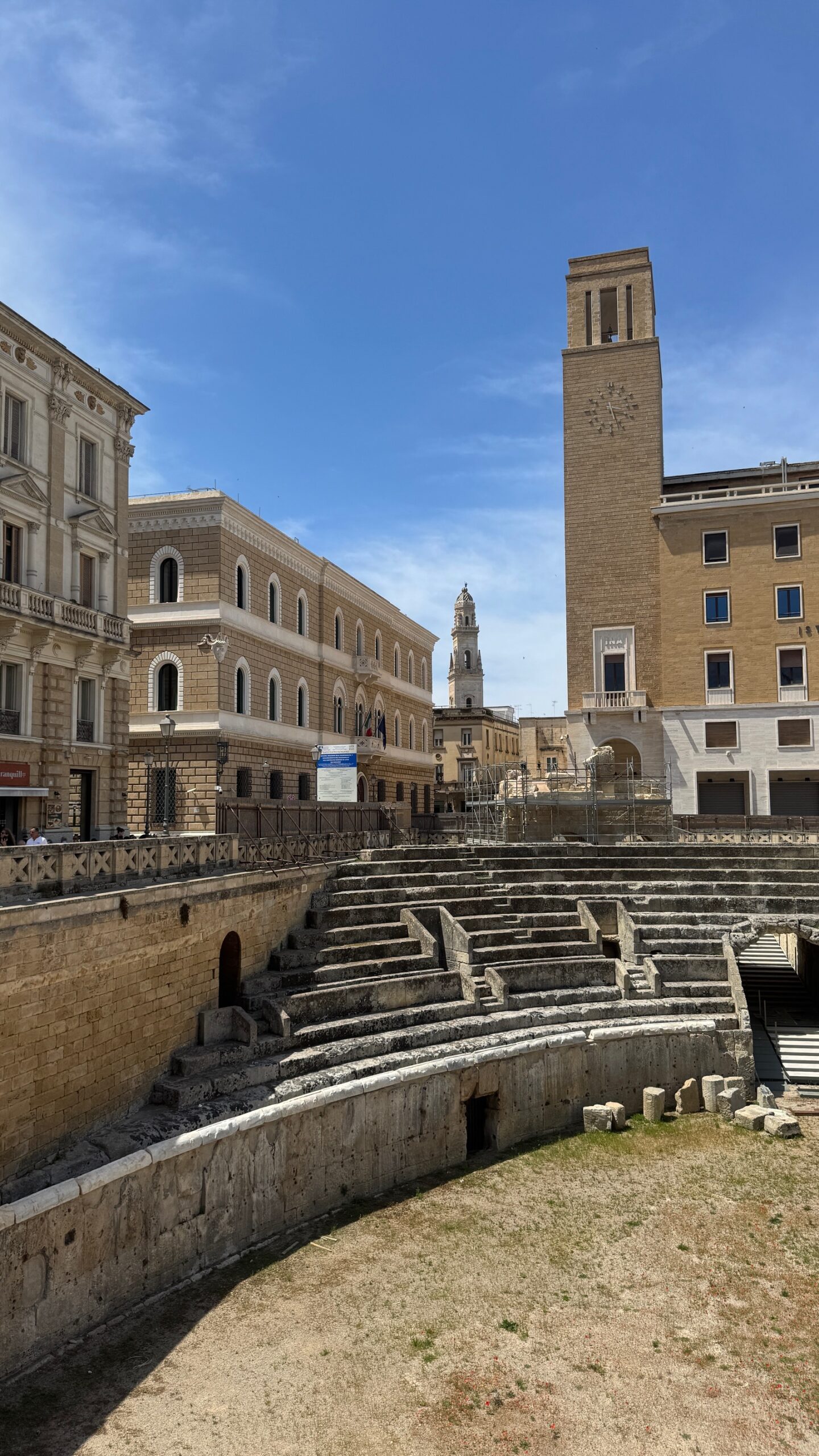
- Otranto – A lovely seaside town with clear turquoise waters, a quaint old town, and a cathedral with an extraordinary mosaic floor that tells biblical stories. Take a stroll along the seafront, enjoy fresh seafood, and explore the Otranto Castle for panoramic views.
- Gallipoli – The old town of Gallipoli is perched on a small island, connected to the mainland by a bridge. It’s a lively, vibrant place with plenty of shops, cafes, and restaurants. Don’t miss the stunning beaches nearby and the Castello di Gallipoli, a fortress offering great views over the sea.

- Santa Maria di Leuca – The southernmost tip of Puglia, where the Adriatic and Ionian seas meet. It’s a dramatic, picturesque spot with rugged coastlines, lighthouse views, and a serene atmosphere that feels like the edge of the world.
- Brindisi – Brindisi is a historic port city that once served as the gateway to the East. It features the Roman Column, marking the end of the ancient Appian Way, and the impressive 12th-century Castello Svevo. The Lungomare, a charming seafront promenade, offers beautiful views of the harbor and the Adriatic Sea—perfect for a leisurely stroll. With its relaxed, authentic atmosphere, Brindisi feels less touristy than other regional cities, making it a nice, cute spot to experience local life. Angel’s tip: However, it’s not a must-see—if you’re pressed for time, you can easily skip it.
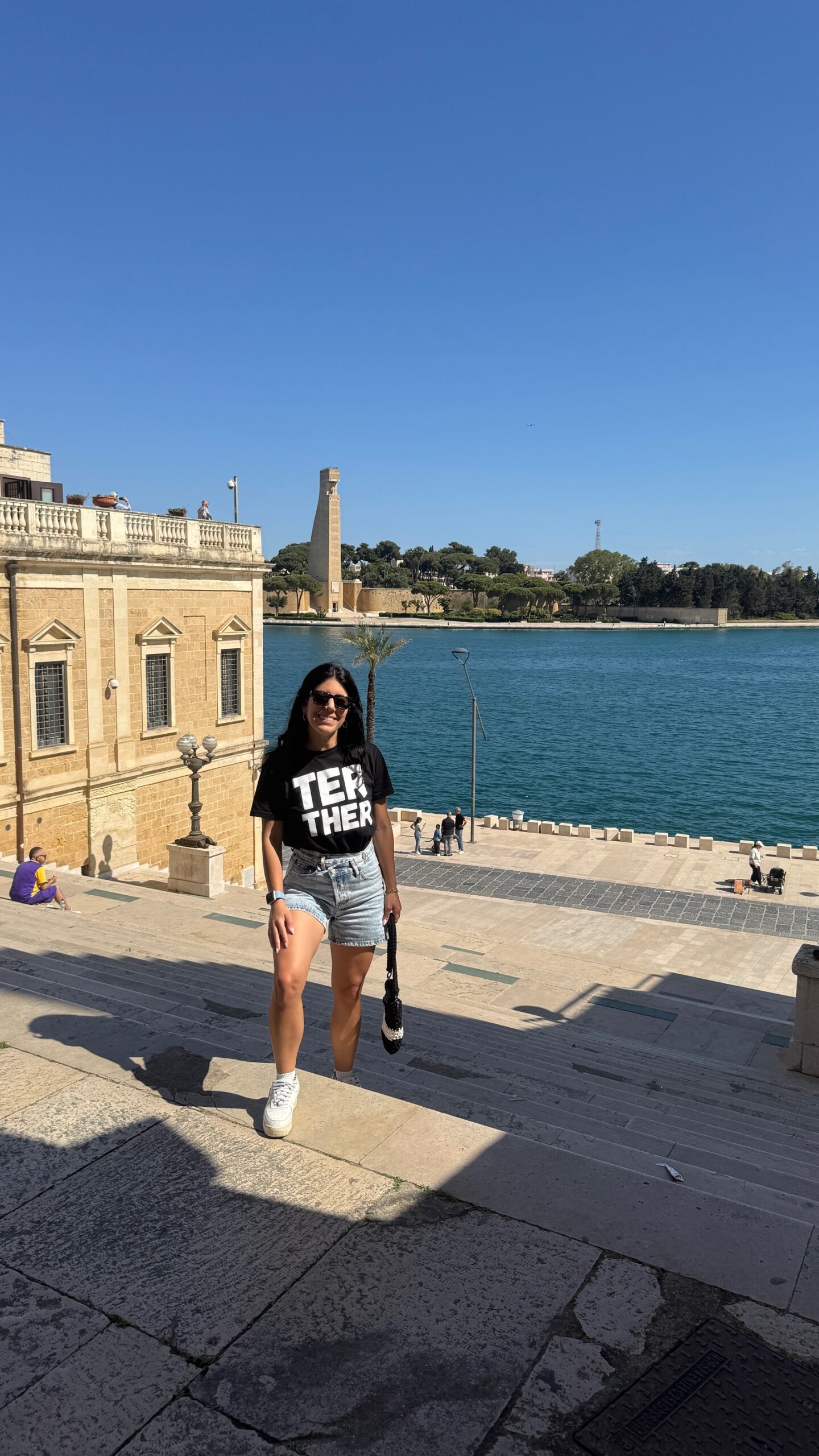
- Taranto — a historic city between two seas, with a stunning castle, rich archaeology museum, lively old town, and excellent seafood. A perfect mix of culture and coastal charm in southern Puglia. Angel’s tip: I had an amazing dinner at a restaurant called Risto Fratelli Pesce. Angel’s tip: If you have time, join the Jonian Dolphin Conservation for an eco-friendly boat tour to see dolphins in their natural habitat along the beautiful Ionian coast.
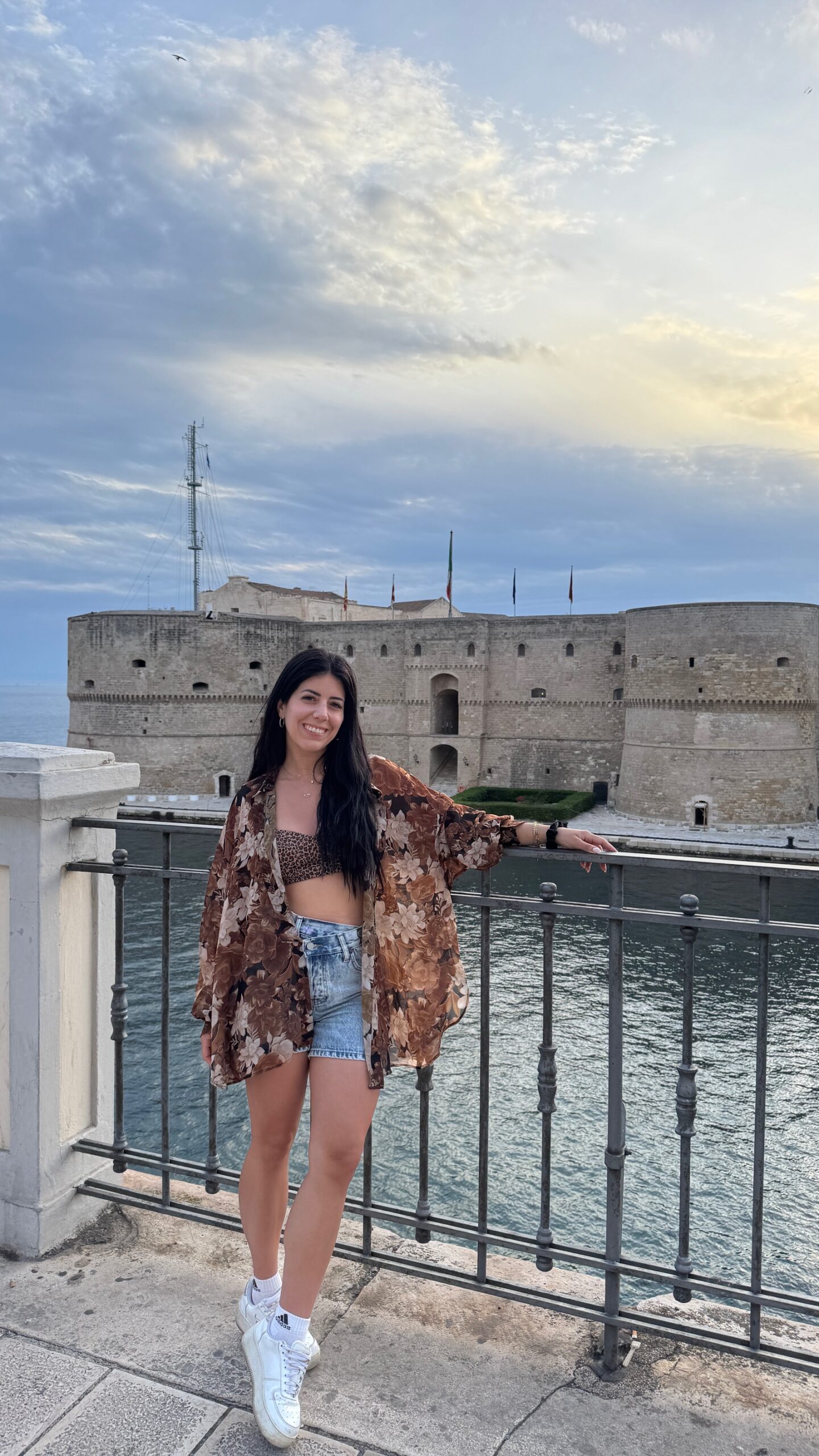
MUST-DO EXPERIENCE IN PUGLIA
Don’t skip to stay or at least visit a Masseria! A masseria is a traditional fortified farmhouse unique to southern Italy, especially Puglia. Many have been beautifully restored into boutique hotels, agriturismos, or countryside retreats, offering an authentic taste of local life.
What You Can Do at a Masseria:
- Join a cooking class (learn to make orecchiette or focaccia!)
- Enjoy wine or olive oil tastings
- Relax by the pool in the peaceful countryside
- Dine farm-to-table with produce grown on-site
- Explore the grounds, gardens, and ancient olive groves
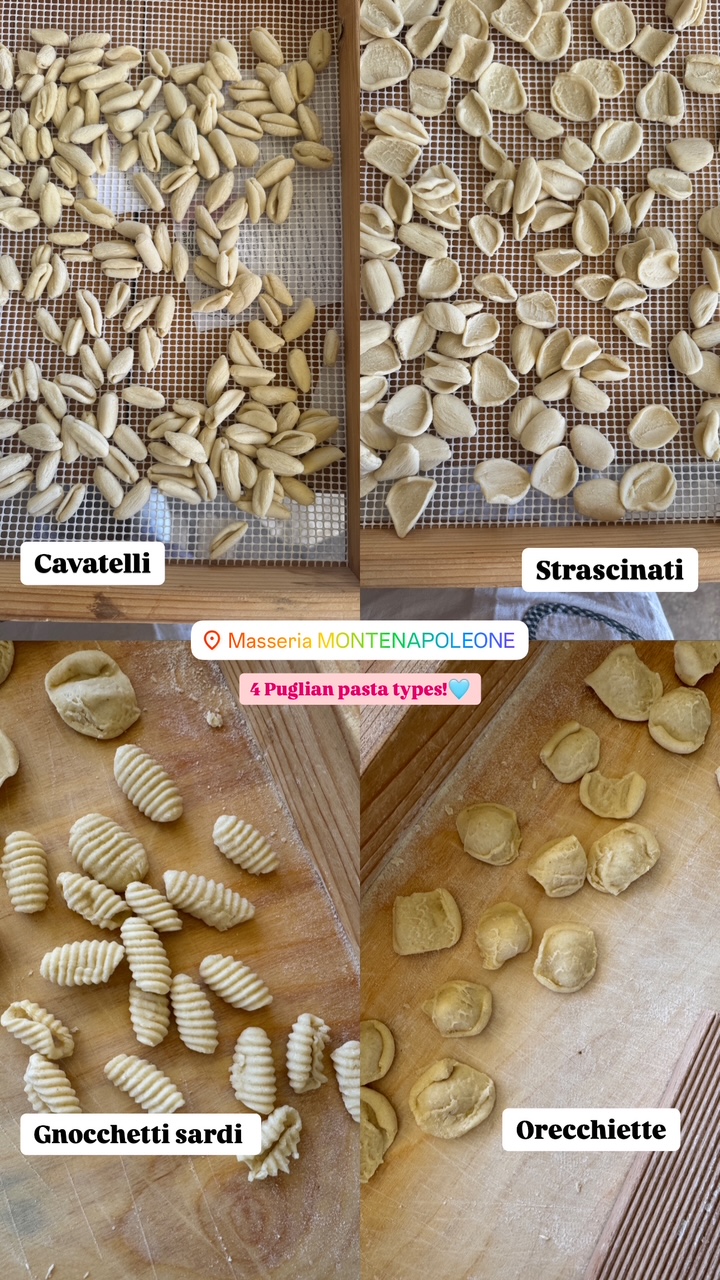
Recommended ones in Puglia:
- Masseria Montenapoleone (near Fasano): rustic-chic, excellent for cooking classes.
Angel’s tip: I booked a cooking class for €55 per person directly through email at info@masseriamontenapoleone.com, and their team was incredibly helpful and responsive.
The experience was fantastic — we learned how to make traditional focaccia and pasta, sipped on a glass of local wine, and enjoyed the magical atmosphere of the masseria.They also offer other wonderful experiences, including:
-A picnic experience (€65 per person)
-A vineyard aperitivo with finger food (€65 per person)
-A vineyard dinner under the stars (€150 per person)
- Masseria Torre Coccaro (Savelletri): luxury meets tradition, with spa & beach club
- Masseria Il Frantoio (near Ostuni): charming and historic, famous for its organic dinners
- Masseria Moroseta (Ostuni): minimalist design, perfect for stylish countryside vibes
- Masseria Salinola (Ostuni) : Family-run, peaceful, and charming. A great option for a relaxing rural base while still being close to Ostuni.
- Masseria Le Stanzie: a 16th-century farmhouse in Supersano, Salento, offering authentic local food made from farm-grown ingredients. Known for its rustic charm, it’s perfect for a traditional Apulian meal in a peaceful countryside setting. Great for food lovers looking for a true local experience. Angel’s tip: Recommended by a friend of mine for an excellent meal.
Angel’s tip: Even if you don’t stay overnight, many masserias offer day experiences or meals — don’t miss out!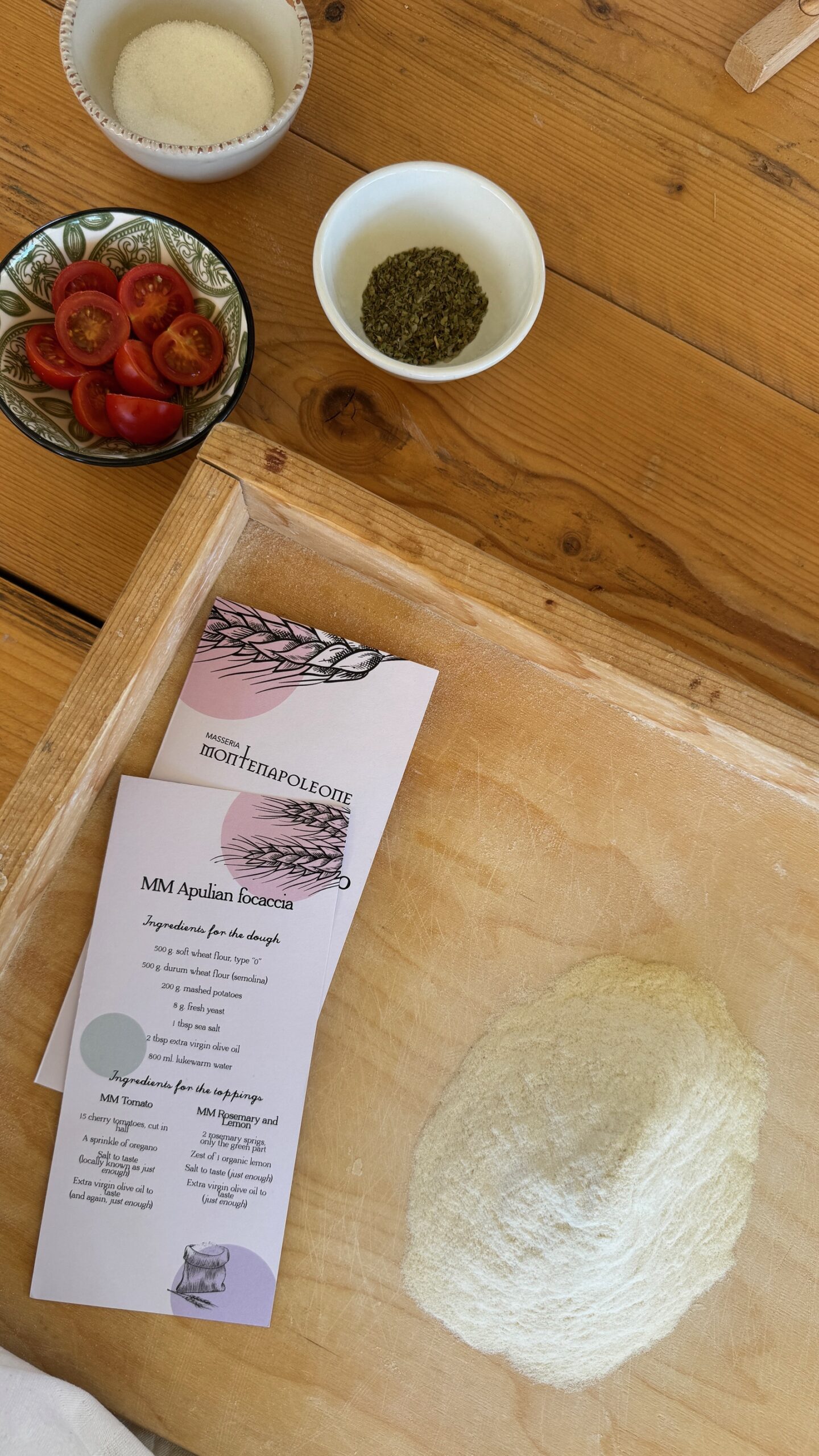
WHAT TO EAT IN PUGLIA
Puglia is a dream for food lovers. The food is fresh, simple, and full of flavor. From pasta and cheese to seafood and wine, here are the must-tries:
- Orecchiette – Handmade pasta shaped like tiny ears. Often served with tomato sauce or broccoli rabe (a little bitter, but tasty!)
- Burrata – A creamy cheese that looks like mozzarella but has a soft, rich center. Best eaten fresh!
- Focaccia Barese – Fluffy bread topped with cherry tomatoes, olives, and olive oil. Great as a snack or starter.
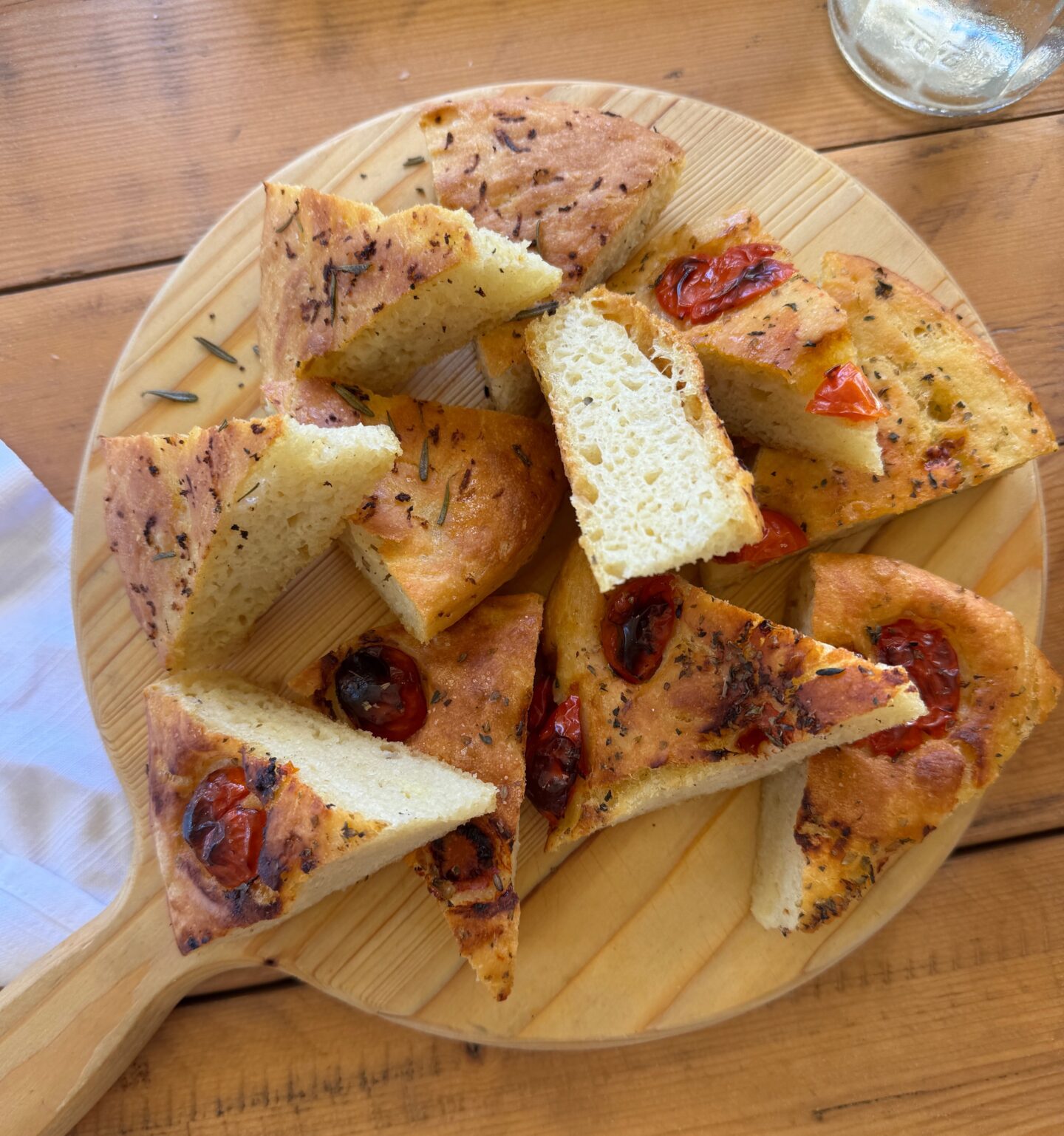
- Panzerotti – Fried dough pockets filled with tomato and mozzarella. Like a mini pizza calzone—so good hot!
- Tarallini – Crunchy little bread rings. Perfect with wine or as a snack on the road.
- Bombette – Grilled pork rolls stuffed with cheese. You’ll find them at butcher shops in towns like Cisternino.
- Pasticiotto – Cream-filled pastry from Lecce, perfect with espresso
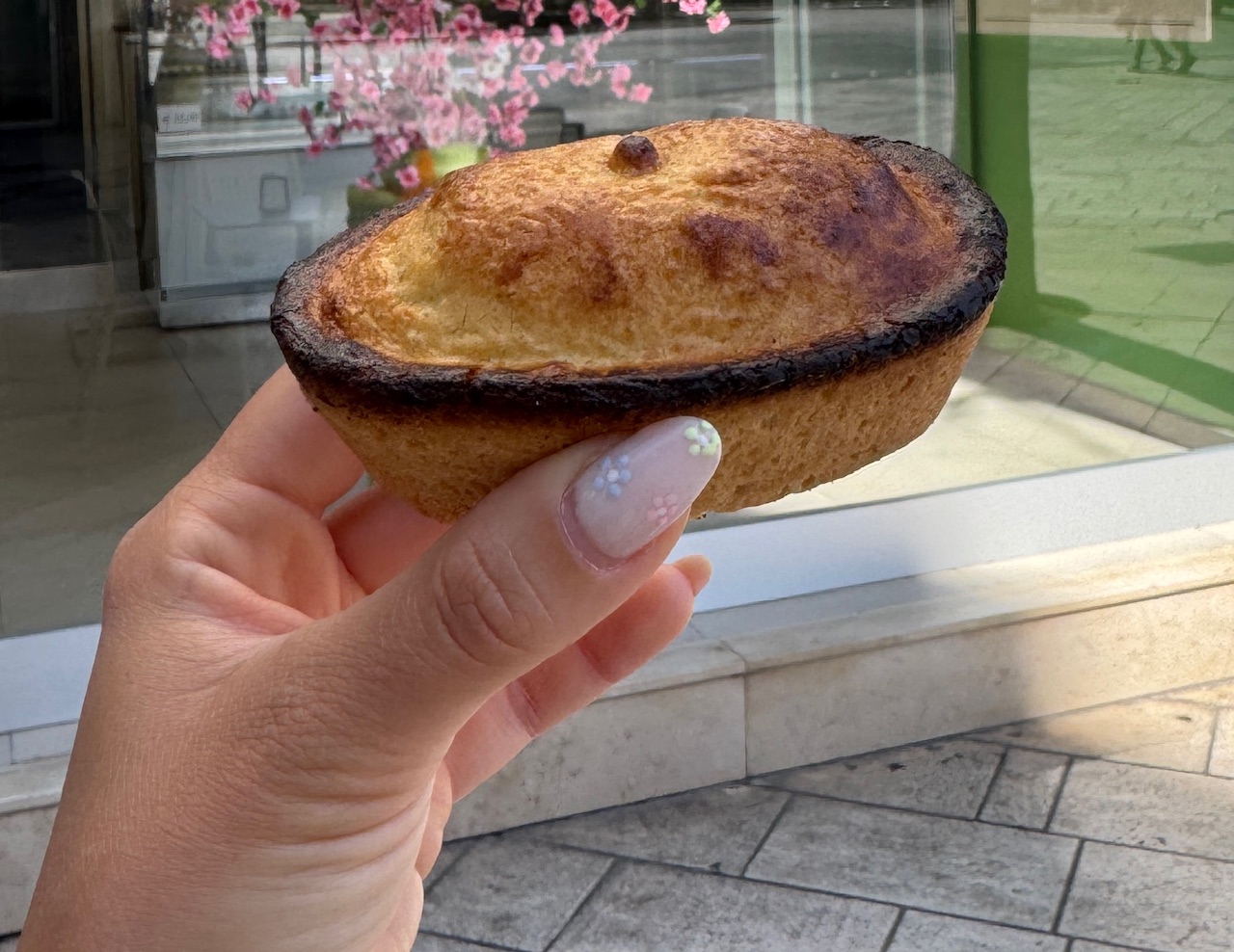
- Cozze alla Tarantina – Mussels cooked in a spicy tomato sauce. Often served with crusty bread to soak up the juice.
Angel’s tip: Try Primitivo Wine – A bold red wine from the region. Pairs perfectly with meats and cheese.
Restaurant Recommendations in Puglia:
Near Polignano a Mare
-
Grotta Palazzese (amazing view in a cave but the food is average) – iconic but overpriced (more than 200euros pp).
-
Mint Cucina Fresca – small, veggie-forward, creative. Angel’s tip: They accept reservations 10 days in advance and you can send them sms.
-
Osteria di Chichibio – solid seafood.
-
Gustavo Salumeria – A lovely little salumeria with delicious panini, local cold cuts, and cheese platters. Great for a quick bite with sea views.
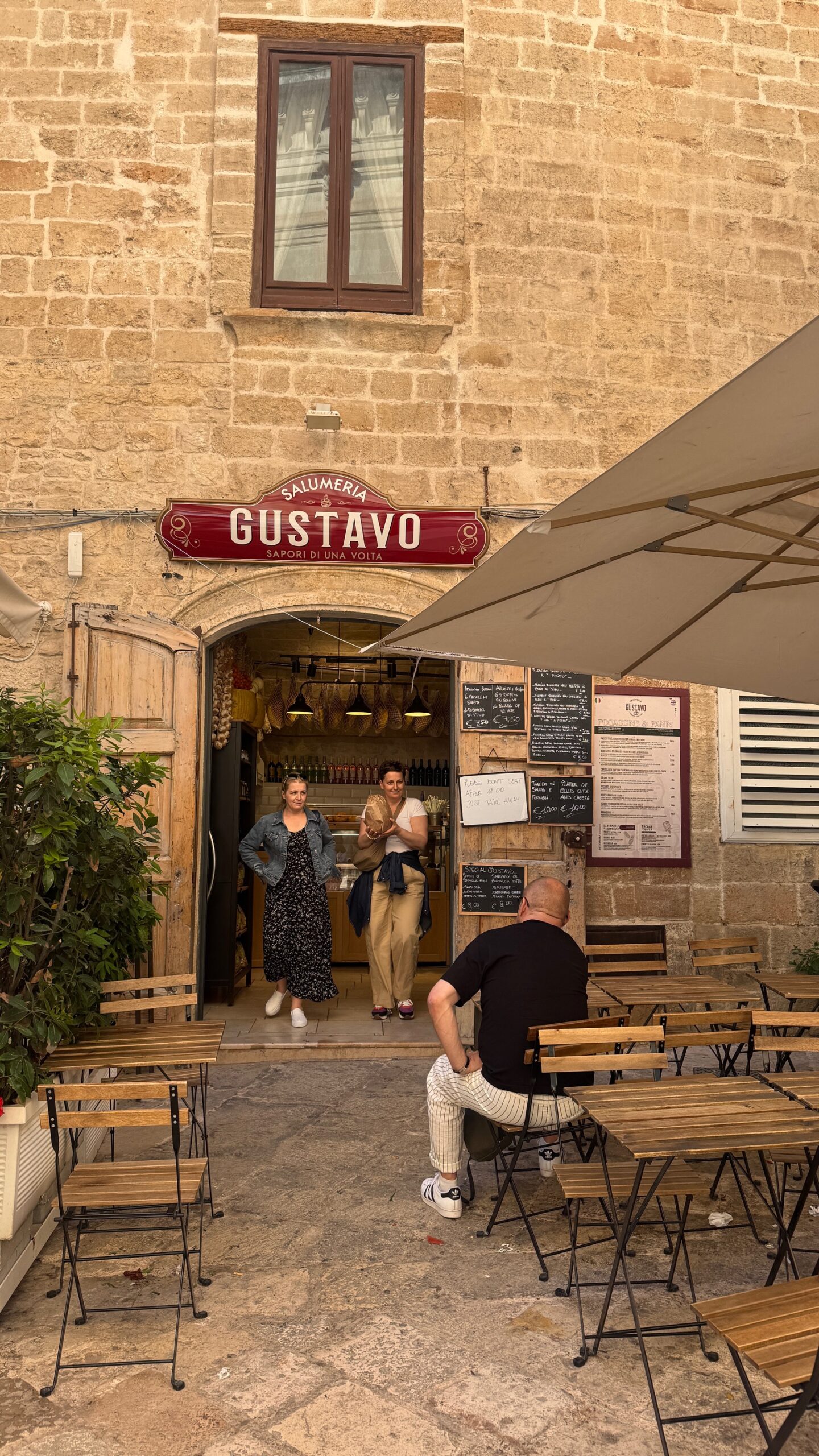
In Monopoli
-
Trattoria La Locanda dei Mercanti – rustic, reliable.
-
Piazza Palmieri – charming location, good pasta.
-
Radimare – A seafood-focused restaurant right by the water. Fresh fish, chic setting, ideal for a relaxed but elegant and more expensive lunch or dinner but delicious.
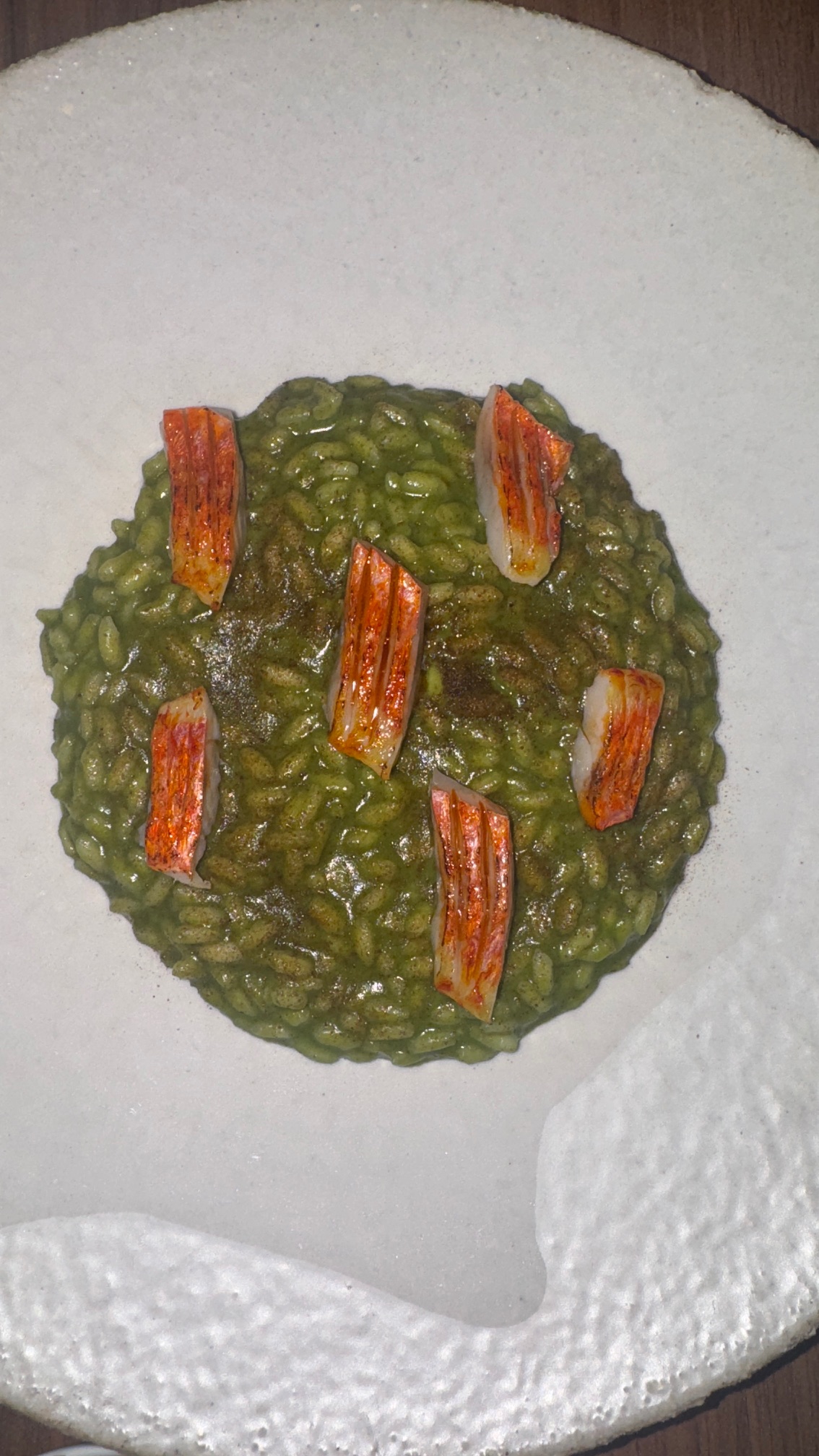
In Cisternino
-
Braceria del Corso – for the famous “bombette” (grilled meat rolls).
-
C’est Délicieux – Affordable and tasty crepes (both sweet and savory) in the center of the town. Perfect for a quick, satisfying stop.

- 3.5 euros for my chocolate crepe
In Ostuni
-
Borgo Antico Bistrot – my personal fave but for the entire setup, not the food!
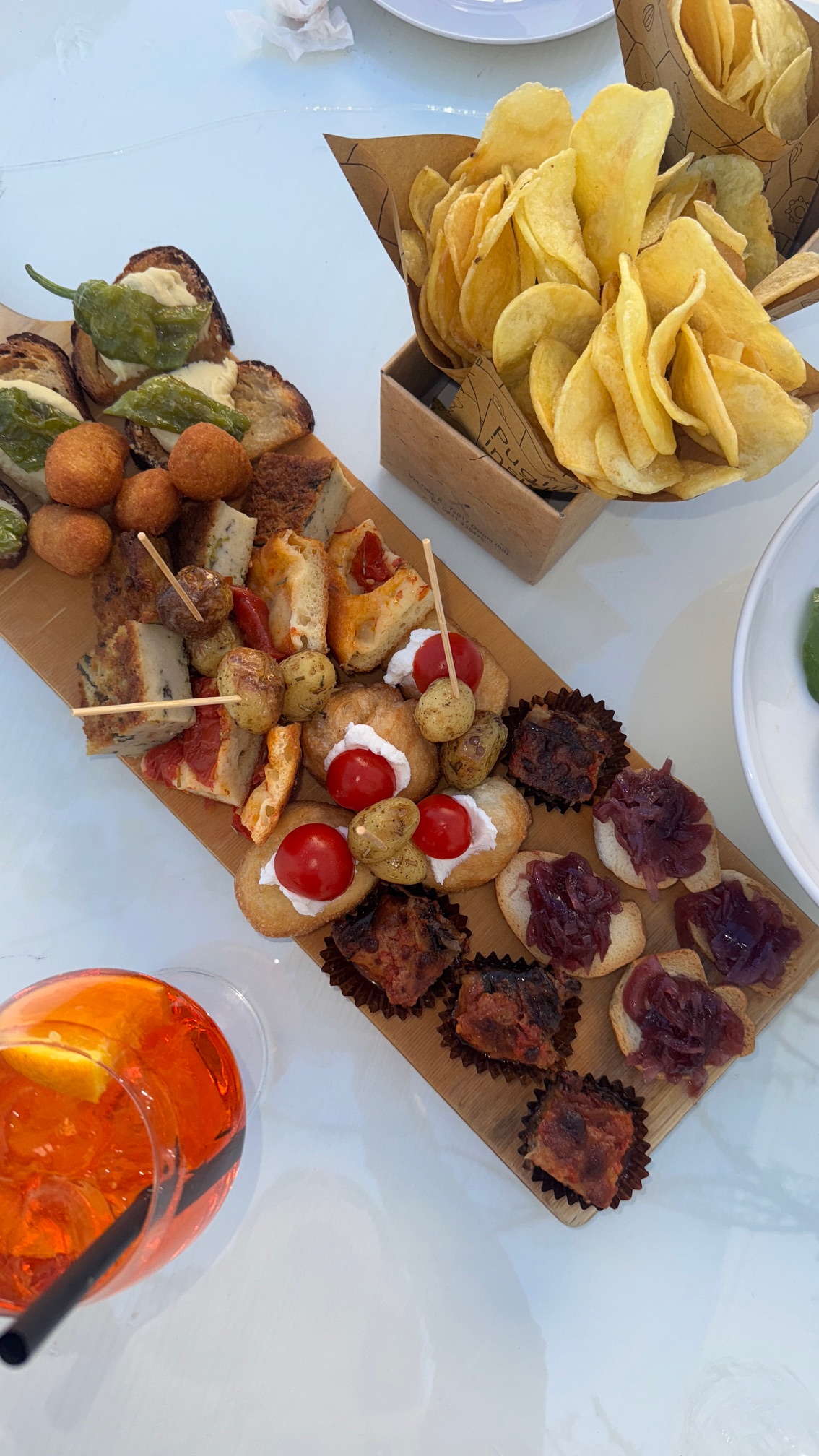
-
Osteria Del Tempo Perso – beautiful cave setting, often recommended.
In Martina Franca / Locorotondo
-
Gaonas Officine del Gusto (Martina Franca) – modern and good quality.
-
U Curdunn (Locorotondo) – traditional and charming.
In Lecce
-
Osteria degli Spiriti – elegant and refined.
-
Trattoria Nonna Tetti – local dishes in a casual setting.
Taranto
-
Ristò Fratelli Pesce – A great choice for seafood in Taranto. Friendly staff, fresh dishes, and good local wine. Perfect if you’re looking for a local dining experience.
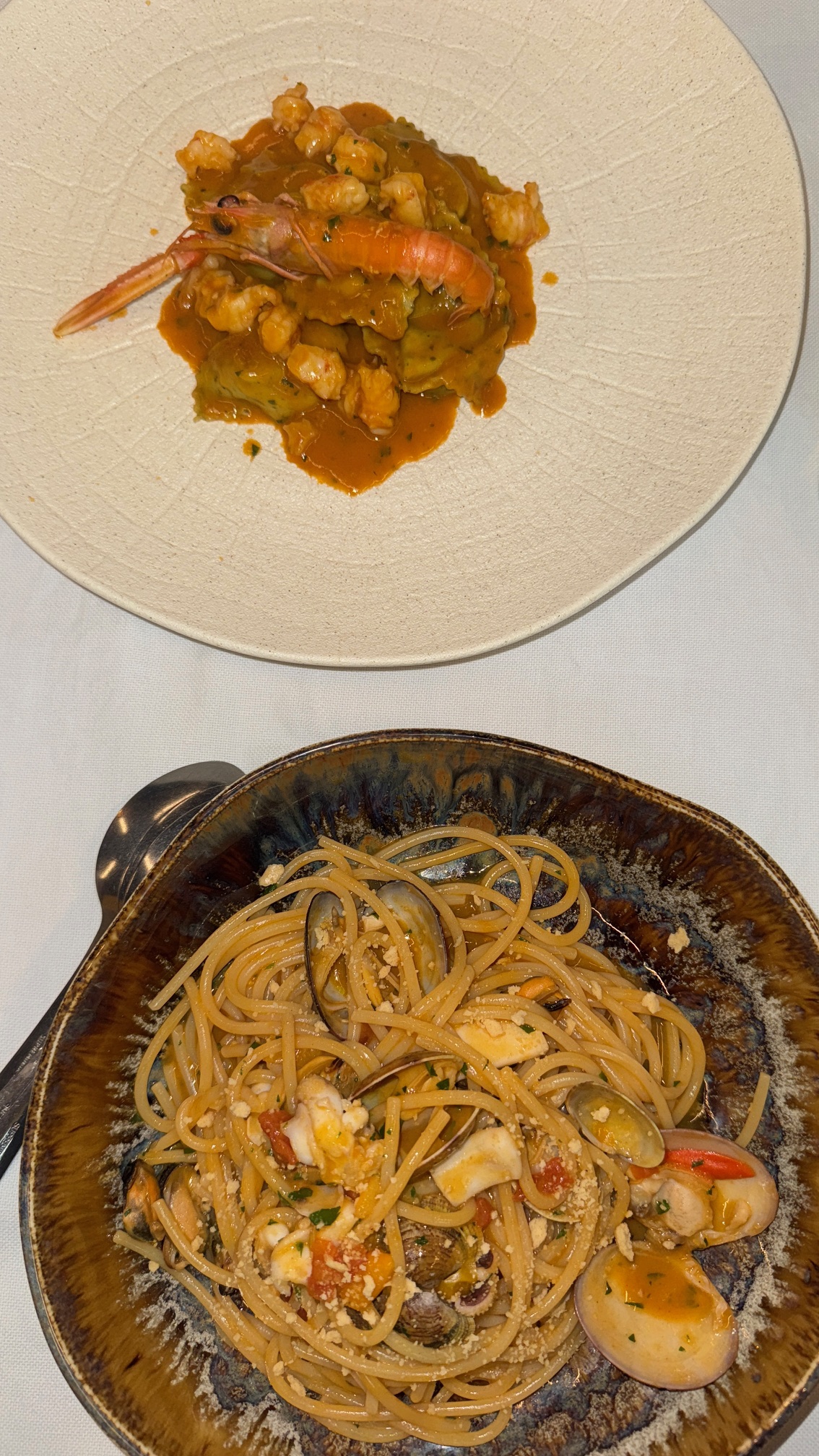
Near Gallipoli
-
La Puritate – well-known seafood spot.
-
Trattoria Portolano (in Santa Maria al Bagno) – quiet gem with sea view.
- La Bitta fish restaurant

BONUS TRIP: MATERA
Italy has 20 regions. Matera belongs to the Basilicata region, next to Puglia, but it’s only about a one-hour drive from Bari and you should definitely include it in your Puglia trip.
Matera is one of the oldest continuously inhabited cities in the world. It’s famous for its “Sassi” – ancient cave dwellings carved into the limestone. The town looks like a movie set, and in fact, many films (like The Passion of the Christ and No Time to Die) were filmed there.
Matera is built into a canyon and feels completely different from other Italian towns. It’s a UNESCO World Heritage Site and was the European Capital of Culture in 2019. Angel’s tip: One full day is enough to explore Matera, but staying overnight is magical.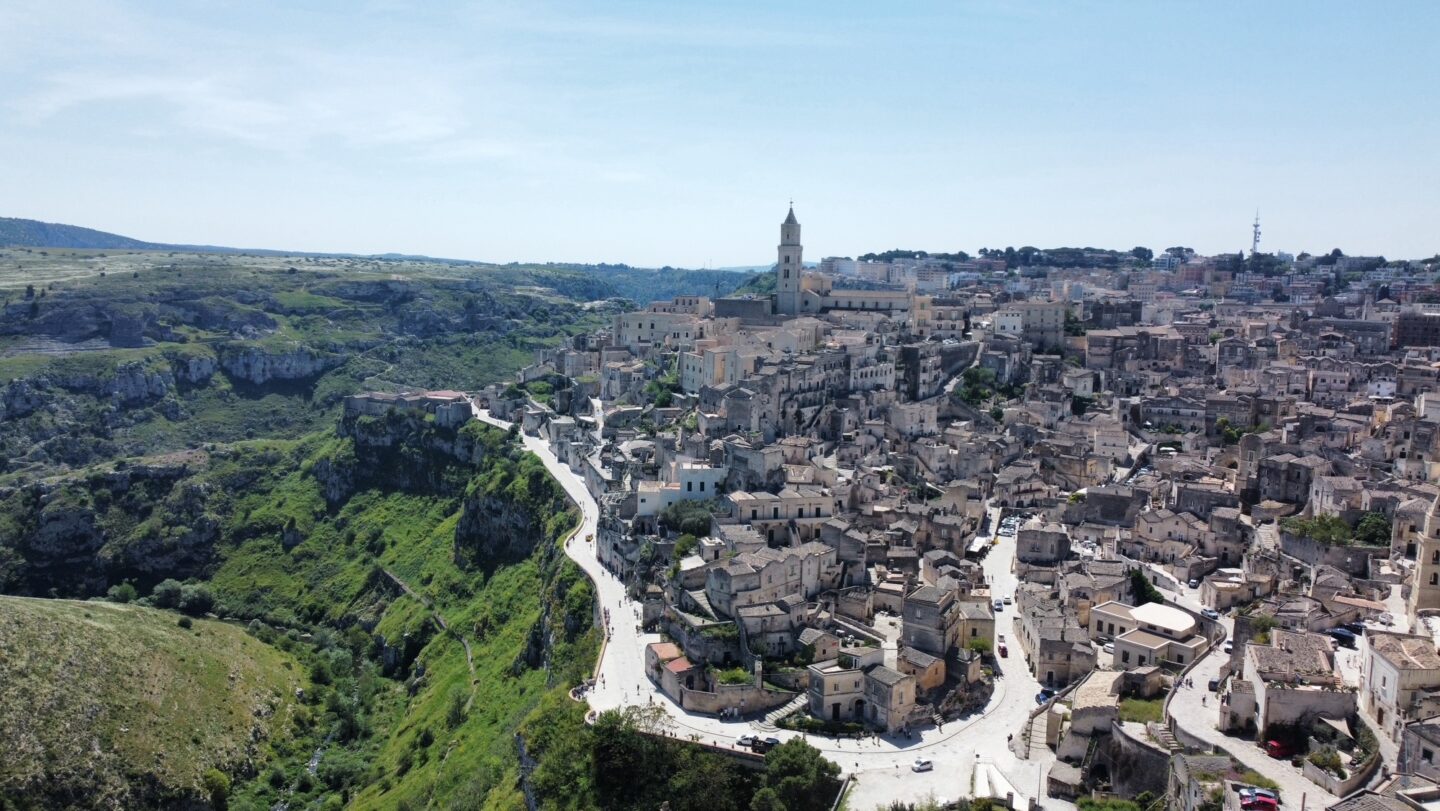
A Bit of History (wow!)
- People have lived in Matera since the Paleolithic period (over 9,000 years ago).
- The Sassi districts were once considered a symbol of poverty, with people living without electricity or running water until the 1950s.
- In the 1950s, the government moved residents out and called it a “national shame.”
- But in the 1980s and 90s, things changed – Matera was restored and became one of Italy’s most unique destinations.
Top Things to Do in Matera
- Wander Through the Sassi: Walk through Sasso Caveoso and Sasso Barisano – the two main historic cave districts. Every corner feels like a photo. Angel’s tip: Wear comfortable shoes—there are lots of steps and cobblestones!
- Cathedral of Matera (Duomo): Beautiful Romanesque church with amazing views over the Sassi.
- Palombaro Lungo: A massive underground water cistern under Piazza Vittorio Veneto. Feels like an underground cathedral. Entrance 3.50 euros.
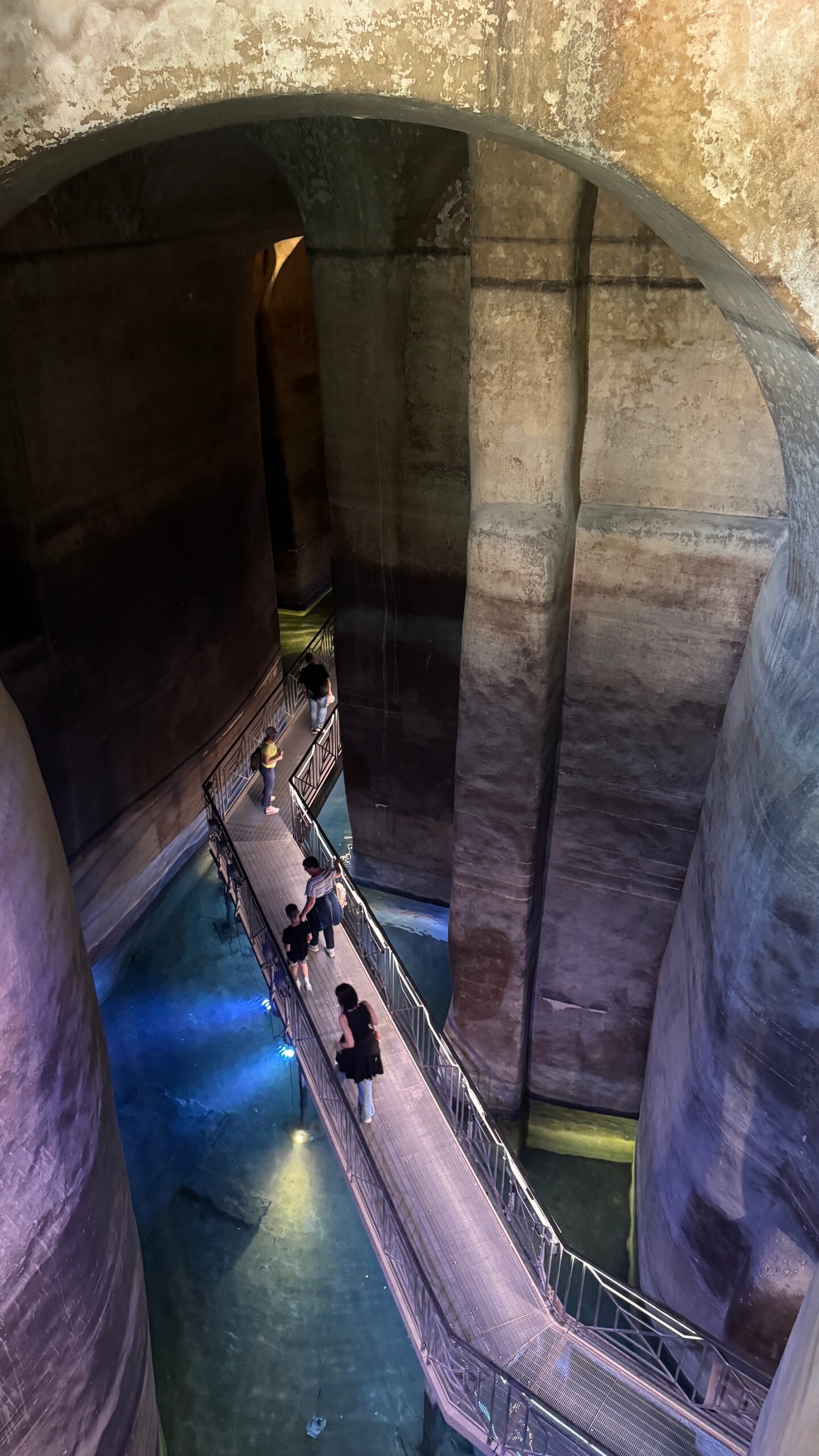
- Belvedere Murgia Timone: For a panoramic view of the whole town—especially magical at sunrise or sunset.
- Visit Casa Grotta: A restored cave house that shows how people lived in Matera until the 1950s. Very authentic and interesting.
- Rock Churches (Chiese Rupestri): These are small churches carved into the rocks, often with old frescoes. Santa Maria de Idris is a must-see.
- Stay or eat in a cave: Many hotels and restaurants are inside caves. It’s a unique experience.
Angel’s tip: My absolute favorite café/bar in Matera is Zipa Café — set inside a cave and full of character. I also loved enjoying the view from places like Crialoss, Terrazza Cavaliere, and 5 Lire Matera for pizza.
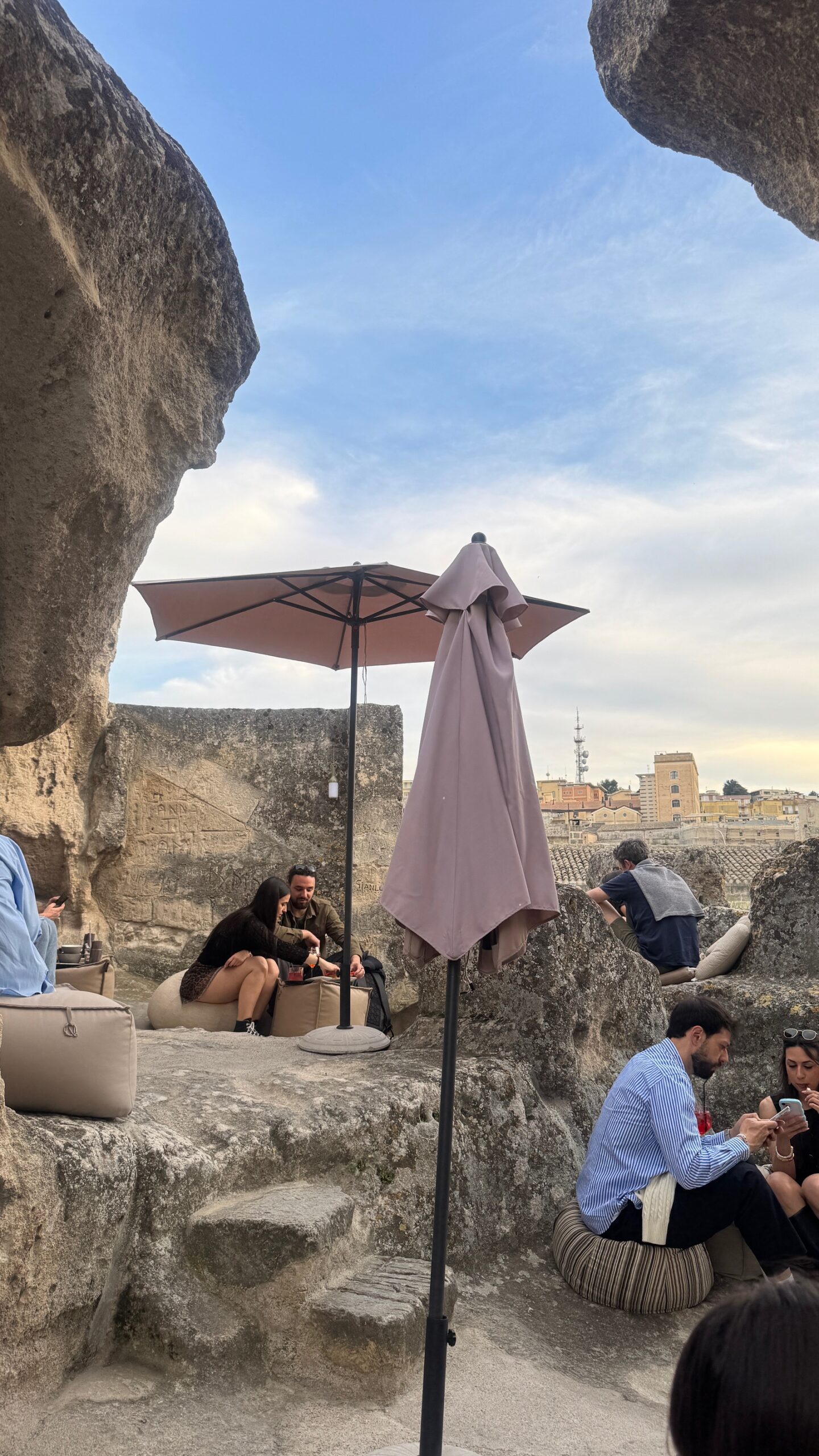
Zipa cafè
SUGGESTED ITINERARIES
3-Day Puglia Itinerary (very packed with Matera)
Day 1: Monopoli + Polignano a Mare + Ostuni
Day 2: Alberobello + Cisternino + Masseria experience
Day 3: Bari (start your day early) + Matera (day trip and stay till night or spend the night even better) 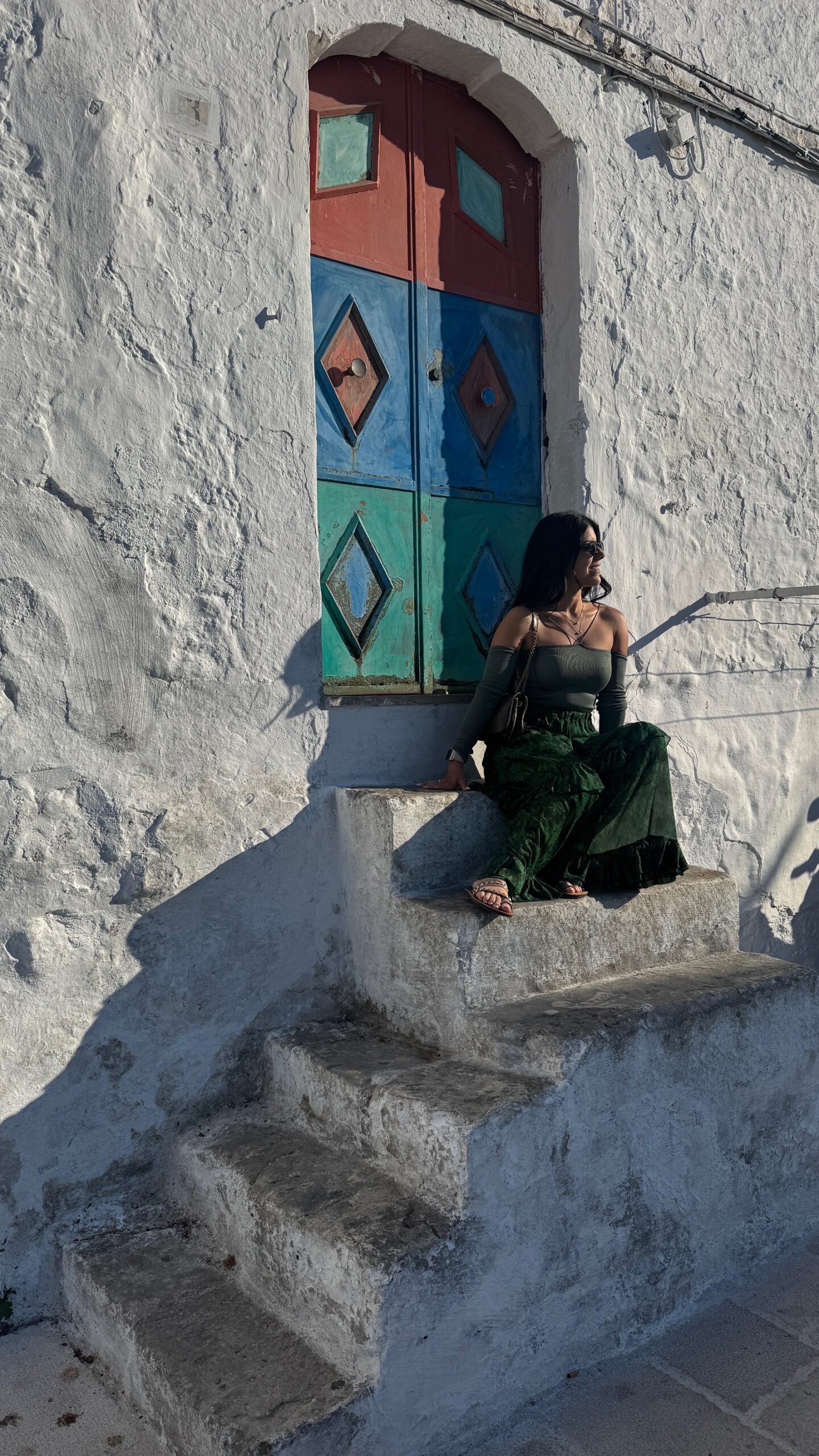
5-Day Puglia Itinerary (with Matera)
Day 1: Monopoli + Polignano a Mare
Day 2: Alberobello + Cisternino (+optional Martina Franca or Locorotondo)
Day 3: Ostuni + Masseria experience (+optional Ceglie Messapica)
Day 4: Gallipoli + Beach (Punta Proscuitto or Baia Verde close for example + optional Nardo or Taranto if there is time)
Day 5: Bari + Matera (day trip)
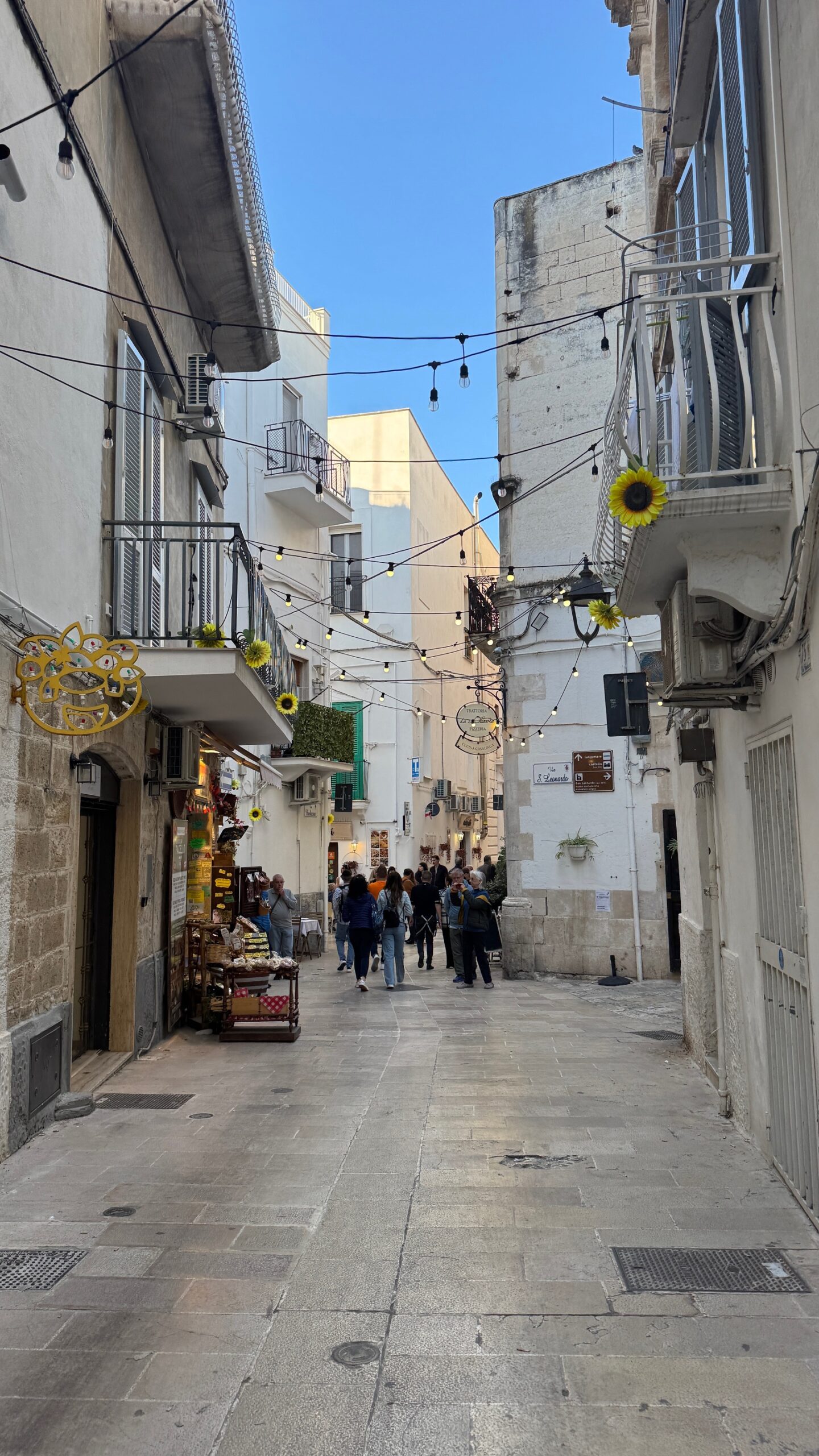
Monopoli old town
1 week Puglia Itinerary (with Matera)
Day 1: Monopoli + Polignano a Mare
Day 2: Alberobello + Cisternino (+optional Locorotondo or Martina Franca)
Day 3: Ostuni (+optional Ceglie Messapica) + Masseria cooking class or wine tasting
Day 4: Gallipoli + Nardò + Beach (if in a summer mood): Punta Prosciutto, Torre Lapillo, Punta della Suina, Baia Verde, Lido Pizzo, Sant’Isidoro, Porto Selvaggio, or Spiaggia della Purità (near Gallipoli old town)
Day 5: Lecce + Otranto + Grotta della Poesia
Day 6: Taranto + Beach (if in a summer mood): Lido Gandoli, Montedarena, Campomarino di Maruggio, Marina di Pulsano + optional Martina Franca or Grottaglie
Day 7: Bari (quick visit) + Matera day trip Angel’s tip: Visit Bari either on arrival or before your flight back for a flexible start or finish, and dedicate a full day to exploring Matera!
Angel’s tip: As mentioned above, if you have time – or especially if you’re traveling with kids – a great idea is to visit Zoosafari in Fasano, one of the largest wildlife parks in Europe with drive-through safaris and fun attractions.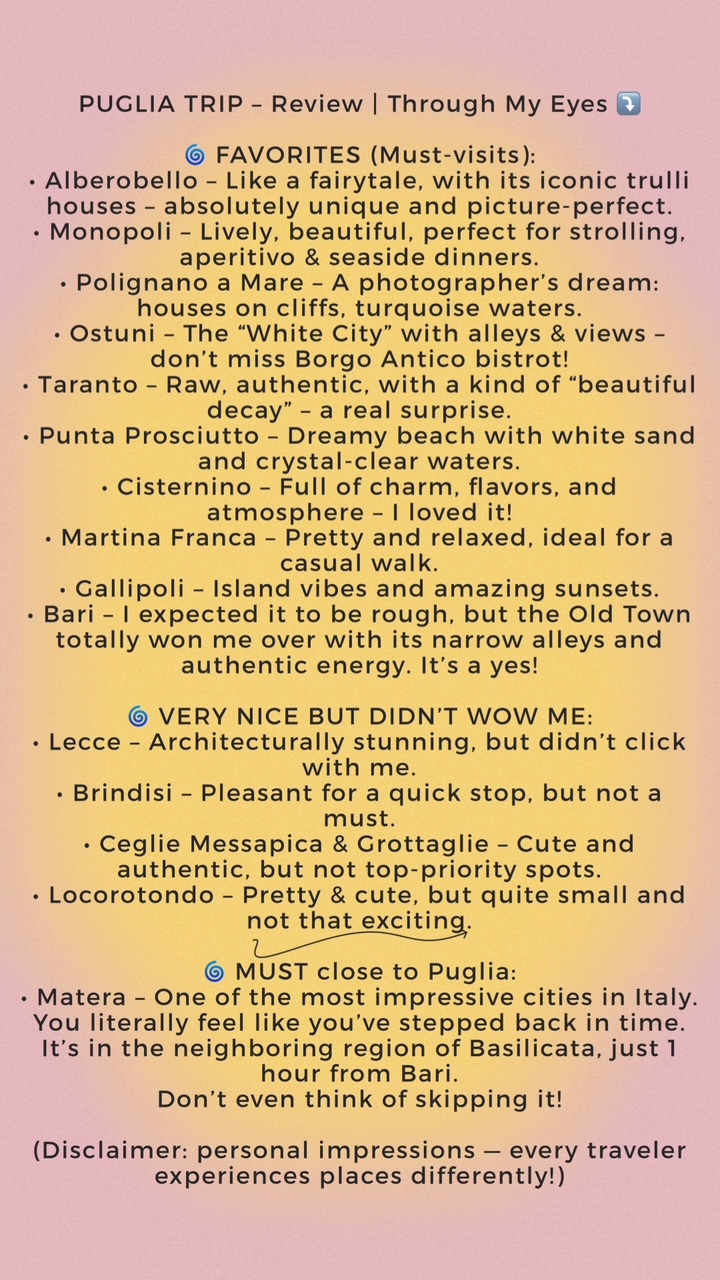
For more pics, check my highlights on Instagram
IG: angeliki.a_
